Kelly Jensen's Blog, page 129
November 11, 2013
Contemporary YA Books Featuring Mental Illness
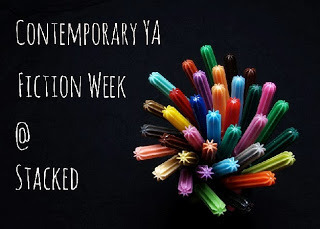
Mental illness and mental well-being are topics that keep emerging in contemporary YA, and they keep being explored in worthwhile -- even life-changing -- ways. This list features very recent contemporary YA titles that have tackled mental illness in some capacity.
All of these titles were published in the last two years, though many, many more titles have come before and many more will come after. This isn't an exhaustive list, but rather one meant to show a range of experiences. Some of the descriptions aren't entirely insightful as to what the mental illness tackled is, and sometimes that's purposeful (The Stone Girl, for example, highlights the eating disorder but there is most definitely a mental illness coexisting with it).
If you have other favorite contemporary realistic YA titles that tackle mental illness and mental well-being from any period of time, feel free to leave the title and author in the comments. And yes, you may borrow and share this list as you see fit.
Descriptions are from WorldCat, unless otherwise noted.
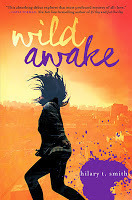
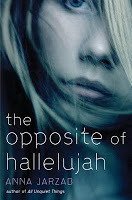

Wild Awake by Hilary T. Smith: The discovery of a startling family secret leads seventeen-year-old Kiri Byrd from a protected and naive life into a summer of mental illness, first love, and profound self-discovery.
Opposite of Hallelujah by Anna Jarzab: For eight of her sixteen years Carolina Mitchell's older sister Hannah has been a nun in a convent, almost completely out of touch with her family--so when she suddenly abandons her vocation and comes home, nobody knows quite how to handle the situation, or guesses what explosive secrets she is hiding.
Something Like Normal by Trish Doller: When Travis returns home from Afghanistan, his parents are splitting up, his brother has stolen his girlfriend and car, and he has nightmares of his best friend getting killed but when he runs into Harper, a girl who has despised him since middle school, life actually starts looking up.
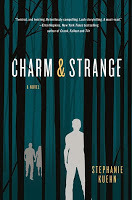
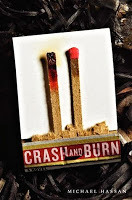
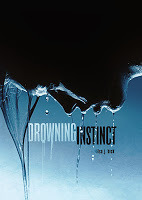
Charm & Strange by Stephanie Kuehn: A lonely teenager exiled to a remote Vermont boarding school in the wake of a family tragedy must either surrender his sanity to the wild wolves inside his mind or learn that surviving means more than not dying.
Crash and Burn by Michael Hassan: Steven "Crash" Crashinsky relates his sordid ten-year relationship with David "Burn" Burnett, the boy he stopped from taking their high school hostage at gunpoint.
Drowning Instinct by Ilsa J. Bick: An emotionally damaged sixteen-year-old girl begins a relationship with a deeply troubled older man.
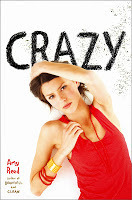
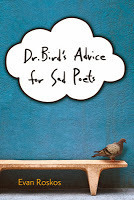
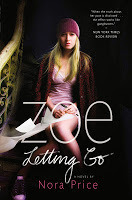
Crazy by Amy Reed: Connor and Izzy, two teens who met at a summer art camp in the Pacific Northwest where they were counsellors, share a series of emails in which they confide in one another, eventally causing Connor to become worried when he realizes that Izzy's emotional highs and lows are too extreme.
Dr. Bird's Advice for Sad Poets by Evan Roskos: A sixteen-year-old boy wrestling with depression and anxiety tries to cope by writing poems, reciting Walt Whitman, hugging trees, and figuring out why his sister has been kicked out of the house.
Zoe Letting Go by Nora Price: Zoe goes to a facility to help cure her anorexia as she comes to terms with the loss of her friend and her own identity.

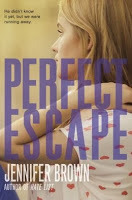
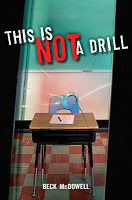
Bruised by Sarah Skilton: When she freezes during a hold-up at the local diner, sixteen-year-old Imogen, a black belt in Tae Kwan Do, has to rebuild her life, including her relationship with her family and with the boy who was with her during the shoot-out.
Perfect Escape by Jennifer Brown: Seventeen-year-old Kendra, living in the shadow of her brother's obsessive-compulsive disorder, takes a life-changing road trip with him.
This is Not A Drill by Beck McDowell: Two teens try to save a class of first-graders from a gun-wielding soldier suffering from PTSD. When high school seniors Emery and Jake are taken hostage in the classroom where they tutor, they must work together to calm both the terrified children and the psychotic gunman threatening them--a task made even more difficult by their recent break-up. Brian Stutts, a soldier suffering from post-traumatic stress disorder after serving in Iraq, uses deadly force when he's denied access to his son because of a custody battle. The children's fate is in the hands of the two teens, each recovering from great loss, who now must reestablish trust in a relationship damaged by betrayal. Told through Emery and Jake's alternating viewpoints, this gripping novel features characters teens will identify with and explores the often-hidden damages of war.
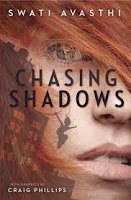
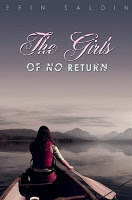
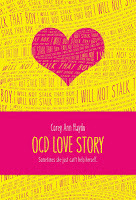
Chasing Shadows by Swati Avasthi: Chasing Shadows is a searing look at the impact of one random act of violence. Before: Corey, Holly, and Savitri are one unit-- fast, strong, inseparable. Together they turn Chicago concrete and asphalt into a freerunner's jungle gym, ricocheting off walls, scaling buildings, leaping from rooftop to rooftop. But acting like a superhero doesn't make you bulletproof. After: Holly and Savitri are coming unglued. Holly says she's chasing Corey's killer, chasing revenge. Savitri fears Holly's just running wild-- and leaving her behind. Friends should stand by each other in times of crisis. But can you hold on too tight? Too long? In this intense novel, told in two voices, and incorporating comic-style art sections, Swati Avasthi creates a gripping portrait of two girls teetering on the edge of grief and insanity. Two girls who will find out just how many ways there are to lose a friend-- and how many ways to be lost.
The Girls of No Return by Erin Saldin: A troubled sixteen-year-old girl attending a wilderness school in the Idaho mountains must finally face the consequences of her complicated friendships with two of the other girls at the school.
OCD Love Story by Corey Ann Haydu: In an instant, Bea felt almost normal with Beck, and as if she could fall in love again, but things change when the psychotherapist who has been helping her deal with past romantic relationships puts her in a group with Beck--a group for teens with obsessive-compulsive disorder.
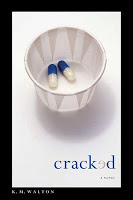
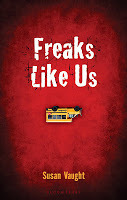
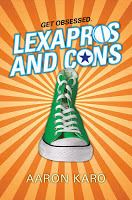
Cracked by K. M. Walton: When Bull Mastrick and Victor Konig wind up in the same psychiatric ward at age sixteen, each recalls and relates in group therapy the bullying relationship they have had since kindergarten, but also facts about themselves and their families that reveal they have much in common.
Freaks Like Us by Susan Vaught: A mentally ill teenager who rides the "short bus" to school investigates the sudden disappearance of his best friend.
Lexapros and Cons by Aaron Karo: Realizing that his OCD (obsessive-compulsive disorder) is out of control, seventeen-year-old Chuck Taylor, who wants to win his best friend back and impress a new girl at school, tries to break some hardcore habits, face his demons--and get messy.
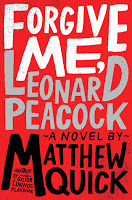
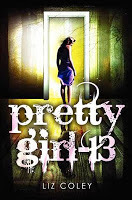
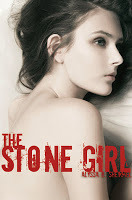
Forgive Me, Leonard Peacock by Matthew Quick: A day in the life of a suicidal teen boy saying good-bye to the four people who matter most to him.
Pretty Girl-13 by Liz Coley: Sixteen-year-old Angie finds herself in her neighborhood with no recollection of her abduction or the three years that have passed since, until alternate personalities start telling her their stories through letters and recordings.
The Stone Girl by Alyssa Sheinmel: Seventeen-year-old Sethie, a senior at New York City's Franklin White girl's school, has outstanding grades, a boyfriend, and a new best friend but constantly struggles to lose weight.







 Related StoriesMental Illness in Contemporary YA: Guest Post from Hilary T. Smith (author of Wild Awake)Contemporary YA Week @ STACKEDGet (sub)Genrefied: Steampunk
Related StoriesMental Illness in Contemporary YA: Guest Post from Hilary T. Smith (author of Wild Awake)Contemporary YA Week @ STACKEDGet (sub)Genrefied: Steampunk
Published on November 11, 2013 10:00
November 10, 2013
Mental Illness in Contemporary YA: Guest Post from Hilary T. Smith (author of Wild Awake)
Let's kick off contemporary week with Hilary T. Smith's post about the importance of good, solid, realistic fiction about mental illness.
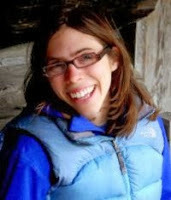
Hilary Smith is the author of the novel WILD AWAKE and of this semi-defunct blog. She lives in Portland, OR, where she is studying North Indian classical music and doing her best to keep the neighbors from having her spaceship van towed.
Burn the Pamphlet, Wrestle With the Bear: Mental Health Narratives and YA Literature
Our cultural scripts for mental illness are pretty uninspiring. The suicide pamphlet in the school nurse's office advises you to Get Help and Speak to a Counselor, where "help" is often a code word for "life-long medication," and the counselor might be the wise healer of your dreams, or might be a not-very-wise adult who hands you another stupid pamphlet and sends you on your way. If you weren't so busy being outlandishly sad or paranoid or hyper, you would be tempted to shout: "People! I am going through what may prove to be one of the most potent and devastating experiences of my life, and you want me to read a fucking pamphlet?"
In a cool culture, they'd send you into the forest to wrestle a grizzly bear, or everyone in your village would surround you in an all-night evil-spirit-dispelling drum circle dance, or they would give you a nice old Pippi Longstocking house on a leafy street where you could live in a way that worked for your brain and didn't bother anyone.
Anyone who has been on the receiving end of the suicide pamphlet (or the OCD pamphlet or the psychosis pamphlet) can tell you that when it comes to talking about mental illness, our culture has a terrifyingly limited vocabulary. We tiptoe. We oversimplify. We squawk the same Top Ten Tips over and over like parrots in a cage.
The conversation about mental illness has become completely jammed up by this squawking, and it's going to take a lot of smart, inquisitive, and imaginative people to unjam it.
This is where YA comes in. Many of those potential conversation-changing people are kids and teens right now. One of the exciting things that YA literature can do is provoke teens to question different elements of their culture—whether you're talking about politics, gender stuff, or reality TV. Why should mental health be excluded from that kind of questioning?
One thing I love about YA right now is that so many books have moved past the "issue-addressing" narratives of previous decades and are delving into the messiness and complexity of experiences like mental illness not as "issues" to be "resolved" but as part of a larger story. What is the difference between an "issue novel" and a novel-novel, and why is this difference important?
 In an issue novel, the Problem is shown to be a certain situation or behavior (teen drinking! disordered eating! manic escapades!) which is shown to cause Conflicts that result in Consequences. The conflicts and consequences surrounding this single situation or behavior are the main drivers of plot and character; the story is over when the situation has been defused and/or the behavior modified. A novel-novel might also involve a problematic situation or behavior which creates conflicts and consequences, but the Problem is shown to be something greater than that choice or behavior. The Problem might be free will, or social justice, or alienation, or finding one's place in the world—but whatever it is, it takes place in a much larger context in which the "problematic situation or behavior" forms a small piece. With that in mind, the plot might not hinge on the situation or behavior or at all—it might simply be taken as part of the background.
In an issue novel, the Problem is shown to be a certain situation or behavior (teen drinking! disordered eating! manic escapades!) which is shown to cause Conflicts that result in Consequences. The conflicts and consequences surrounding this single situation or behavior are the main drivers of plot and character; the story is over when the situation has been defused and/or the behavior modified. A novel-novel might also involve a problematic situation or behavior which creates conflicts and consequences, but the Problem is shown to be something greater than that choice or behavior. The Problem might be free will, or social justice, or alienation, or finding one's place in the world—but whatever it is, it takes place in a much larger context in which the "problematic situation or behavior" forms a small piece. With that in mind, the plot might not hinge on the situation or behavior or at all—it might simply be taken as part of the background.
If The Catcher In The Rye was an issue novel, we might see Holden Caulfield receiving counseling for the death of his brother, getting help for his drinking habit, making up with his parents, and going back to school.
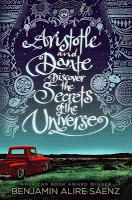 If Wonder When You'll Miss Me was an issue novel, the story would most almost certaintly revolve around the protagonist "coming to terms" with her highschool tormentor instead of hitting him in the head with an axe and running away to join the circus with her imaginary twin.
If Wonder When You'll Miss Me was an issue novel, the story would most almost certaintly revolve around the protagonist "coming to terms" with her highschool tormentor instead of hitting him in the head with an axe and running away to join the circus with her imaginary twin.
In Dante and Aristotle Discover the Secrets of the Universe, the teenaged characters drive into the desert to smoke pot. In a lesser version of the story, the pot smoking would be discovered and addressed and Made Into An Issue; luckily for the reader, Benamin Alire Saenz allows it to simply be a beautiful and believable part of the story.
So how do we write YA novels involving mental illness without turning them into issue novels? First, ask yourself if a given behavior or situation really needs to be treated as an "issue" at all (with all the capital-r Resolutions that this entails). Is mental illness really the main source of conflict in the story? Or can mental illness be part of a story about love, or freedom, or intergalactic space wars? Do you need to "Resolve" it in a dramatic way? Or can you treat it like Dante and Aristotle's illicit toking in the desert?
As a YA writer, you are quite literally affecting the range of stories teen can access about mental illness. Are you going to hand them another pamphlet, or send them to wrestle with the bear?
***
Hilary has offered up a signed copy of Wild Awake to one winner. Enter below and I'll draw a name at the end of the month.
Loading...






 Related StoriesContemporary YA Week @ STACKEDGet (sub)Genrefied: SteampunkA Literary Development Company Talks With Us: Welcome CAKE!
Related StoriesContemporary YA Week @ STACKEDGet (sub)Genrefied: SteampunkA Literary Development Company Talks With Us: Welcome CAKE!

Hilary Smith is the author of the novel WILD AWAKE and of this semi-defunct blog. She lives in Portland, OR, where she is studying North Indian classical music and doing her best to keep the neighbors from having her spaceship van towed.
Burn the Pamphlet, Wrestle With the Bear: Mental Health Narratives and YA Literature
Our cultural scripts for mental illness are pretty uninspiring. The suicide pamphlet in the school nurse's office advises you to Get Help and Speak to a Counselor, where "help" is often a code word for "life-long medication," and the counselor might be the wise healer of your dreams, or might be a not-very-wise adult who hands you another stupid pamphlet and sends you on your way. If you weren't so busy being outlandishly sad or paranoid or hyper, you would be tempted to shout: "People! I am going through what may prove to be one of the most potent and devastating experiences of my life, and you want me to read a fucking pamphlet?"
In a cool culture, they'd send you into the forest to wrestle a grizzly bear, or everyone in your village would surround you in an all-night evil-spirit-dispelling drum circle dance, or they would give you a nice old Pippi Longstocking house on a leafy street where you could live in a way that worked for your brain and didn't bother anyone.
Anyone who has been on the receiving end of the suicide pamphlet (or the OCD pamphlet or the psychosis pamphlet) can tell you that when it comes to talking about mental illness, our culture has a terrifyingly limited vocabulary. We tiptoe. We oversimplify. We squawk the same Top Ten Tips over and over like parrots in a cage.
The conversation about mental illness has become completely jammed up by this squawking, and it's going to take a lot of smart, inquisitive, and imaginative people to unjam it.
This is where YA comes in. Many of those potential conversation-changing people are kids and teens right now. One of the exciting things that YA literature can do is provoke teens to question different elements of their culture—whether you're talking about politics, gender stuff, or reality TV. Why should mental health be excluded from that kind of questioning?
One thing I love about YA right now is that so many books have moved past the "issue-addressing" narratives of previous decades and are delving into the messiness and complexity of experiences like mental illness not as "issues" to be "resolved" but as part of a larger story. What is the difference between an "issue novel" and a novel-novel, and why is this difference important?
 In an issue novel, the Problem is shown to be a certain situation or behavior (teen drinking! disordered eating! manic escapades!) which is shown to cause Conflicts that result in Consequences. The conflicts and consequences surrounding this single situation or behavior are the main drivers of plot and character; the story is over when the situation has been defused and/or the behavior modified. A novel-novel might also involve a problematic situation or behavior which creates conflicts and consequences, but the Problem is shown to be something greater than that choice or behavior. The Problem might be free will, or social justice, or alienation, or finding one's place in the world—but whatever it is, it takes place in a much larger context in which the "problematic situation or behavior" forms a small piece. With that in mind, the plot might not hinge on the situation or behavior or at all—it might simply be taken as part of the background.
In an issue novel, the Problem is shown to be a certain situation or behavior (teen drinking! disordered eating! manic escapades!) which is shown to cause Conflicts that result in Consequences. The conflicts and consequences surrounding this single situation or behavior are the main drivers of plot and character; the story is over when the situation has been defused and/or the behavior modified. A novel-novel might also involve a problematic situation or behavior which creates conflicts and consequences, but the Problem is shown to be something greater than that choice or behavior. The Problem might be free will, or social justice, or alienation, or finding one's place in the world—but whatever it is, it takes place in a much larger context in which the "problematic situation or behavior" forms a small piece. With that in mind, the plot might not hinge on the situation or behavior or at all—it might simply be taken as part of the background.
If The Catcher In The Rye was an issue novel, we might see Holden Caulfield receiving counseling for the death of his brother, getting help for his drinking habit, making up with his parents, and going back to school.
 If Wonder When You'll Miss Me was an issue novel, the story would most almost certaintly revolve around the protagonist "coming to terms" with her highschool tormentor instead of hitting him in the head with an axe and running away to join the circus with her imaginary twin.
If Wonder When You'll Miss Me was an issue novel, the story would most almost certaintly revolve around the protagonist "coming to terms" with her highschool tormentor instead of hitting him in the head with an axe and running away to join the circus with her imaginary twin.
In Dante and Aristotle Discover the Secrets of the Universe, the teenaged characters drive into the desert to smoke pot. In a lesser version of the story, the pot smoking would be discovered and addressed and Made Into An Issue; luckily for the reader, Benamin Alire Saenz allows it to simply be a beautiful and believable part of the story.
So how do we write YA novels involving mental illness without turning them into issue novels? First, ask yourself if a given behavior or situation really needs to be treated as an "issue" at all (with all the capital-r Resolutions that this entails). Is mental illness really the main source of conflict in the story? Or can mental illness be part of a story about love, or freedom, or intergalactic space wars? Do you need to "Resolve" it in a dramatic way? Or can you treat it like Dante and Aristotle's illicit toking in the desert?
As a YA writer, you are quite literally affecting the range of stories teen can access about mental illness. Are you going to hand them another pamphlet, or send them to wrestle with the bear?
***
Hilary has offered up a signed copy of Wild Awake to one winner. Enter below and I'll draw a name at the end of the month.
Loading...







 Related StoriesContemporary YA Week @ STACKEDGet (sub)Genrefied: SteampunkA Literary Development Company Talks With Us: Welcome CAKE!
Related StoriesContemporary YA Week @ STACKEDGet (sub)Genrefied: SteampunkA Literary Development Company Talks With Us: Welcome CAKE!
Published on November 10, 2013 22:00
November 9, 2013
Contemporary YA Week @ STACKED
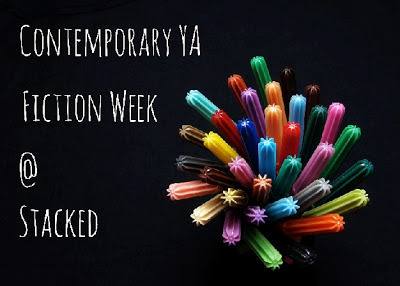
Welcome to the third annual contemporary YA fiction week here at STACKED. I am so, so excited to get this week kicked off because there is so much great stuff to share.
Like in years past, I have a nice array of guest posts from contemporary YA authors. We're going to travel across the globe to talk about Australian contemporary YA, we'll talk about mental illness and contemporary YA, humor in contemporary YA, and much, much more. In fact, I have 7 guest posts lined up, along with a host of book lists.
After seeing what people were interested in reading about earlier this year, I noticed some of the topics that were mentioned were topics that have been covered here before -- either during a prior contemporary week or elsewhere. I thought that in addition to new posts, I'd rerun some older content, as well, in order to give a huge range of voices and insights into contemporary YA.
So in short, contemporary YA week will be a little longer than one week this year. It'll be closer to a week and a half long, with two posts a day. I promise a lot of worthwhile reading, thought-provoking guest posts, and, I hope, useful book lists of titles within a given topic and titles to get on your radar for the coming year.
And perhaps -- just perhaps -- I'll tell you a little bit more about my book about contemporary YA sometime at the end of this series.
Contemporary YA fiction week will start tomorrow with a guest post about mental illness as it's depicted in YA, with a sharp take on the idea of "the problem novel."







 Related StoriesGet (sub)Genrefied: SteampunkA Literary Development Company Talks With Us: Welcome CAKE!A Closer Look at The New York Times YA Bestsellers List, Part 2
Related StoriesGet (sub)Genrefied: SteampunkA Literary Development Company Talks With Us: Welcome CAKE!A Closer Look at The New York Times YA Bestsellers List, Part 2
Published on November 09, 2013 22:00
November 7, 2013
Primates by Jim Ottaviani and Maris Wicks
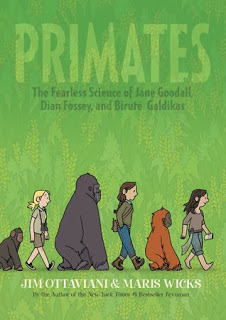
Primates is a nonfiction gem. Ottaviani and Wicks tell the interlocking stories of three female scientists who did groundbreaking research with primates: Jane Goodall, Dian Fossey, and Birute Galdikas. All three women lived with the primates they studied (chimps, gorillas, and orangutans, respectively), and all three made significant contributions to their fields.
Of particular interest is the fact that they were all able to do their work because of their association with noted male scientist Louis Leakey - the three women were all dubbed "Leakey's Angels" as a result. Leakey believed women were uniquely qualified for this type of research, and he was able to secure the funding to make it happen. There's certainly an element of frustration knowing that brilliant female scientists needed another male scientist to make it possible for them to do their work.
I also found it interesting that two of the three women (Goodall and Fossey) actively eschewed traditional education (by this I mainly mean advanced college degrees), finding it unnecessary and even counterproductive. It's only the third and youngest, Galdikas, who was already pursuing an advanced degree when she met Leakey, several years after Goodall and Fossey had begun their research with him. I can't help but feel that the distaste for a degree has a lot to do with the traditional maleness of it as well as the very hands-off nature of such things, which didn't appeal to these scientists who literally lived alongside their subjects.
This is the kind of book that inspires the reader to find out more about the subjects after the last page is turned. In so doing, I discovered that Ottaviani and Wicks significantly glossed over Fossey's death - they refer to it, but make no mention of the fact she was murdered, the case still unsolved today (mostly). It's not an exhaustive biography. Ottaviani mentions in the author's note that the book is a hybrid of fiction and nonfiction - he had to fill in the gaps and speculate at some points. It's told in first person, with Goodall narrating the first part, Fossey the second, and Galdikas the third. All three scientists narrate the last few pages, their voices intermingling. During this section, we get some idea of what they thought of each other, which I found very interesting. While the handwriting is different for each scientist, I did find it a bit difficult to distinguish who was narrating at times.
It's in full-color, eye-catching and gorgeous. I'm so glad it is; it would be a travesty not to see the fantastic nature scenes depicted in all their glory. The three women look distinct from each other, and each is easily identifiable in a real-life photograph at the end of the book. This is excellent nonfiction with high appeal. I was amazed at what these women did, and I loved knowing that two of them continue to do amazing work today. I think this fact will make it seem relevant to kids - especially girls - who love science and animals, and it may inspire them to think of doing something like this themselves one day.
I never thought I'd find primates so fascinating. I still don't think I really do. But the scientists? Definitely so.
Copy borrowed from the library.







 Related StoriesThe In-Between by Barbara StewartAudiobook Review: The Waking Dark by Robin WassermanJuvie by Steve Watkins
Related StoriesThe In-Between by Barbara StewartAudiobook Review: The Waking Dark by Robin WassermanJuvie by Steve Watkins
Published on November 07, 2013 22:00
November 6, 2013
Get (sub)Genrefied: Steampunk
Every month, we're highlighting one genre within YA fiction as part of Angela's reader's advisory challenge. So far, we've discussed horror, science fiction, high fantasy, mysteries and thrillers, verse novels, contemporary realistic fiction, historical fiction, graphic novels, romances, and dystopias. November's focus is another subgenre: steampunk.
Steampunk is not a subgenre either of us are very familiar with, but I know I've enjoyed getting to know it a bit more for this guide. So what exactly is steampunk? It's a subgenre of science fiction, and its primary characteristic is that it features steam-powered machines, often anachronistically. What this means is that steampunk stories may include complex steam-powered contraptions in a time (such as the 19th century) when the technology for such things never existed (making it alternate history). They also often feature this type of technology in a future world, making the stories a fun combination of futuristic and retro. The "classic" steampunk story is also culturally Western, frequently Victorian-era British.
(I will say that the machines I've found in books described as steampunk aren't always steam-powered. For a different sort of definition, take this one from the Steampunk Bible: a grafting of Victorian aesthetic and punk rock attitude onto various forms of science-fiction culture. As with other genres and subgenres, people define it in different ways.)
Like other genre fiction, there's lots of genre-blending that goes on. You'll find steampunk crossed with historical fiction, romance, mystery, fantasy, horror, and others. It's part of what makes reading genre fiction such an adventure - the possibilities are endless.
Perhaps more so than other genres and subgenres, steampunk has lent itself to an entire culture beyond the books. People dress up in steampunk costumes and wear steampunk jewelry. Often, they'll make their own. Fans make and sell steampunk art. Shops have sprung up online to sell these items to buyers all over. I've noticed that most of those passionate about steampunk tend to be adults - but I don't doubt that there are many avid teen fans as well.
Below are a few resources if you'd like to learn more about the subgenre (from people more knowledgeable about it than me, no doubt!):
The aforementioned Steampunk Bible by Jeff VanderMeer is the book to get if you're interested in diving headlong into the genre/culture. The Ranting Dragon gives us 20 Must-Read Steampunk Books in an article from 2011 (including YA titles) as well as a good, concise definition.AbeBooks discusses the history of the subgenre and offers more reading recommendations in their Steampunk 101 article.In a 2010 article, Library Journal offers up 20 core steampunk titles, including classics as well as more recent works. The New York Public Library recently wrote this fantastic piece about steampunk for teens, including a reading list. Steamed is the collaborative blog of a group of steampunk writers, and it's full of information. Posts include Steampunk for Beginners, Women in Steampunk, and Beyond Steampunk. They also run Steampunkapalooza, a yearly celebration of all things steampunk.As part of Steampunkapalooza this year, Teen Librarian Toolbox collected some excellent craft ideas plus rounded up links to other good content.Because this is a smaller subgenre without as many recent books to its name, I've broadened the list below to include notable titles older than five years. These titles, while older, should still be of interest to teens curious about the genre, especially since they've often influenced the more recent ones. Descriptions are from Worldcat. As always, please chime in if we've missed any.
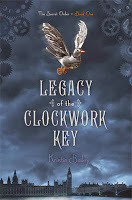
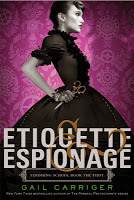
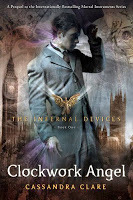
Legacy of the Clockwork Key by Kristin Bailey: A orphaned sixteen-year-old servant in Victorian England finds love while unraveling the secrets of a mysterious society of inventors and their most dangerous creation.
Etiquette and Espionage and sequel by Gail Carriger: In an alternate England of 1851, spirited fourteen-year-old Sophronia is enrolled in a finishing school where, she is suprised to learn, lessons include not only the fine arts of dance, dress, and etiquette, but also diversion, deceit, and espionage.
Clockwork Angel and sequels by Cassandra Clare: When sixteen-year-old orphan Tessa Gray's older brother suddenly vanishes, her search for him leads her into Victorian-era London's dangerous supernatural underworld, and when she discovers that she herself is a Downworlder, she must learn to trust the demon-killing Shadowhunters if she ever wants to learn to control her powers and find her brother.
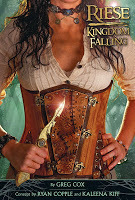
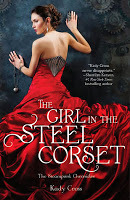
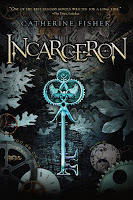
Riese: Kingdom Falling by Greg Cox: Riese has never been happy as a princess; she'd much rather be hunting or fighting than sitting through another lesson on court etiquette. When she meets Micah, a wandering artist with a mysterious past, she pretends to be a peasant--it's a chance to be just a normal girl with a normal boy for a while. But with war decimating her once-proud nation and the sinister clockwork Sect infiltrating her mother's court, Riese's moments with Micah are the only islands of sanity left in a world gone mad. As her kingdom falls and the Sect grows ever stronger, will Riese remain true to her duty as a princess...or risk everything on a boy she barely knows?
Girl in the Steel Corset and sequels by Kady Cross: Finley, who has a beastly alter ego inside of her, joins Duke Griffin's army of misfits to help stop the Machinist, the criminal behind a series of automaton crimes, from carrying out a plan to kill Queen Victoria during the Jubilee.
Incarceron and sequel by Catherine Fisher: To free herself from an upcoming arranged marriage, Claudia, the daughter of the Warden of Incarceron, a futuristic prison with a mind of its own, decides to help a young prisoner escape.
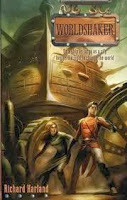
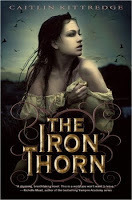
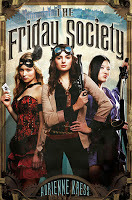
Worldshaker by Richard Harland: Sixteen-year-old Col Porpentine is being groomed as the next Commander of Worldshaker, a juggernaut where elite families live on the upper decks while the Filthies toil below, but when he meets Riff, a Filthy girl on the run, he discovers how ignorant he is of his home and its residents.
The Iron Thorn and sequels by Caitlin Kittredge: In an alternate 1950s, mechanically gifted fifteen-year-old Aoife Grayson, whose family has a history of going mad at sixteen, must leave the totalitarian city of Lovecraft and venture into the world of magic to solve the mystery of her brother's disappearance and the mysteries surrounding her father and the Land of Thorn.
The Friday Society by Adrienne Kress: Cora, Nellie, and Michiko, teenaged assistants to three powerful men in Edwardian London, meet by chance at a ball that ends with the discovery of a murdered man, leading the three to work together to solve this and related crimes without drawing undue attention to themselves.

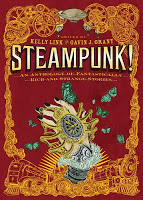
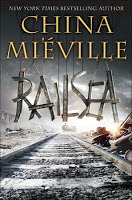
Innocent Darkness and sequels by Suzanne Lazear: In 1901, on an alternate Earth, sixteen-year-old Noli rejoices when a mysterious man transports her from reform school to the Realm of Faerie, until Noli learns his sinister reason.
Steampunk! edited by Kelly Link: A collection of fourteen fantasy stories by well-known authors, set in the age of steam engines and featuring automatons, clockworks, calculating machines, and other marvels that never existed.
Railsea by China Mieville: On board the moletrain Medes, Sham Yes ap Soorap watches in awe as he witnesses his first moldywarpe hunt: the giant mole bursting from the earth, the harpoonists targeting their prey, the battle resulting in one's death & the other's glory. But no matter how spectacular it is, Sham can't shake the sense that there is more to life than traveling the endless rails of the railsea--even if his captain can think only of the hunt for the ivory-colored mole she's been chasing since it took her arm all those years ago.
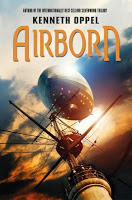
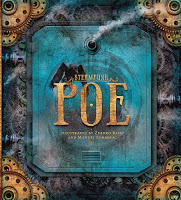
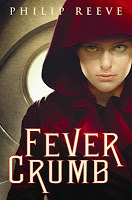
Airborn and sequels by Kenneth Oppel: Matt, a young cabin boy aboard an airship, and Kate, a wealthy young girl traveling with her chaperone, team up to search for the existence of mysterious winged creatures reportedly living hundreds of feet above the Earth's surface.
Steampunk Poe: Presents a collection of Poe's short stories and poems, including "The Tell-Tale Heart," "The Fall of the House of Usher," and "The Raven," accompanied by steampunk-inspired illustrations.
Fever Crumb by Philip Reeve: Foundling Fever Crumb has been raised as an engineer although females in the future London, England, are not believed capable of rational thought, but at age fourteen she leaves her sheltered world and begins to learn startling truths about her past while facing danger in the present.
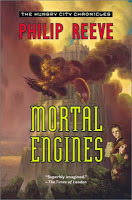
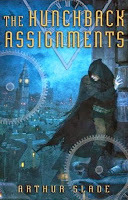
Mortal Engines and sequels by Philip Reeve: In the distant future, when cities move about and consume smaller towns, a fifteen-year-old apprentice is pushed out of London by the man he most admires and must seek answers in the perilous Out-Country, aided by one girl and the memory of another.
The Hunchback Assignments and sequels by Arthur Slade: In Victorian London, fourteen-year-old Modo, a shape-changing hunchback, becomes a secret agent for the Permanent Association, which strives to protect the world from the evil machinations of the Clockwork Guild.

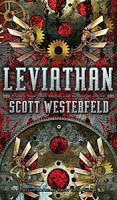
Corsets and Clockwork edited by Trisha Telep: Collects thirteen original stories set during the Victorian era, including tales of steam-powered machines, family secrets, and love.
Leviathan and sequels by Scott Westerfeld: In an alternate 1914 Europe, fifteen-year-old Austrian Prince Alek, on the run from the Clanker Powers who are attempting to take over the globe using mechanical machinery, forms an uneasy alliance with Deryn who, disguised as a boy to join the British Air Service, is learning to fly genetically engineered beasts.






 Related StoriesA Literary Development Company Talks With Us: Welcome CAKE!A Closer Look at The New York Times YA Bestsellers List, Part 2A Closer Look at The New York Times YA Bestsellers List, Part 1
Related StoriesA Literary Development Company Talks With Us: Welcome CAKE!A Closer Look at The New York Times YA Bestsellers List, Part 2A Closer Look at The New York Times YA Bestsellers List, Part 1
Steampunk is not a subgenre either of us are very familiar with, but I know I've enjoyed getting to know it a bit more for this guide. So what exactly is steampunk? It's a subgenre of science fiction, and its primary characteristic is that it features steam-powered machines, often anachronistically. What this means is that steampunk stories may include complex steam-powered contraptions in a time (such as the 19th century) when the technology for such things never existed (making it alternate history). They also often feature this type of technology in a future world, making the stories a fun combination of futuristic and retro. The "classic" steampunk story is also culturally Western, frequently Victorian-era British.
(I will say that the machines I've found in books described as steampunk aren't always steam-powered. For a different sort of definition, take this one from the Steampunk Bible: a grafting of Victorian aesthetic and punk rock attitude onto various forms of science-fiction culture. As with other genres and subgenres, people define it in different ways.)
Like other genre fiction, there's lots of genre-blending that goes on. You'll find steampunk crossed with historical fiction, romance, mystery, fantasy, horror, and others. It's part of what makes reading genre fiction such an adventure - the possibilities are endless.
Perhaps more so than other genres and subgenres, steampunk has lent itself to an entire culture beyond the books. People dress up in steampunk costumes and wear steampunk jewelry. Often, they'll make their own. Fans make and sell steampunk art. Shops have sprung up online to sell these items to buyers all over. I've noticed that most of those passionate about steampunk tend to be adults - but I don't doubt that there are many avid teen fans as well.
Below are a few resources if you'd like to learn more about the subgenre (from people more knowledgeable about it than me, no doubt!):
The aforementioned Steampunk Bible by Jeff VanderMeer is the book to get if you're interested in diving headlong into the genre/culture. The Ranting Dragon gives us 20 Must-Read Steampunk Books in an article from 2011 (including YA titles) as well as a good, concise definition.AbeBooks discusses the history of the subgenre and offers more reading recommendations in their Steampunk 101 article.In a 2010 article, Library Journal offers up 20 core steampunk titles, including classics as well as more recent works. The New York Public Library recently wrote this fantastic piece about steampunk for teens, including a reading list. Steamed is the collaborative blog of a group of steampunk writers, and it's full of information. Posts include Steampunk for Beginners, Women in Steampunk, and Beyond Steampunk. They also run Steampunkapalooza, a yearly celebration of all things steampunk.As part of Steampunkapalooza this year, Teen Librarian Toolbox collected some excellent craft ideas plus rounded up links to other good content.Because this is a smaller subgenre without as many recent books to its name, I've broadened the list below to include notable titles older than five years. These titles, while older, should still be of interest to teens curious about the genre, especially since they've often influenced the more recent ones. Descriptions are from Worldcat. As always, please chime in if we've missed any.



Legacy of the Clockwork Key by Kristin Bailey: A orphaned sixteen-year-old servant in Victorian England finds love while unraveling the secrets of a mysterious society of inventors and their most dangerous creation.
Etiquette and Espionage and sequel by Gail Carriger: In an alternate England of 1851, spirited fourteen-year-old Sophronia is enrolled in a finishing school where, she is suprised to learn, lessons include not only the fine arts of dance, dress, and etiquette, but also diversion, deceit, and espionage.
Clockwork Angel and sequels by Cassandra Clare: When sixteen-year-old orphan Tessa Gray's older brother suddenly vanishes, her search for him leads her into Victorian-era London's dangerous supernatural underworld, and when she discovers that she herself is a Downworlder, she must learn to trust the demon-killing Shadowhunters if she ever wants to learn to control her powers and find her brother.



Riese: Kingdom Falling by Greg Cox: Riese has never been happy as a princess; she'd much rather be hunting or fighting than sitting through another lesson on court etiquette. When she meets Micah, a wandering artist with a mysterious past, she pretends to be a peasant--it's a chance to be just a normal girl with a normal boy for a while. But with war decimating her once-proud nation and the sinister clockwork Sect infiltrating her mother's court, Riese's moments with Micah are the only islands of sanity left in a world gone mad. As her kingdom falls and the Sect grows ever stronger, will Riese remain true to her duty as a princess...or risk everything on a boy she barely knows?
Girl in the Steel Corset and sequels by Kady Cross: Finley, who has a beastly alter ego inside of her, joins Duke Griffin's army of misfits to help stop the Machinist, the criminal behind a series of automaton crimes, from carrying out a plan to kill Queen Victoria during the Jubilee.
Incarceron and sequel by Catherine Fisher: To free herself from an upcoming arranged marriage, Claudia, the daughter of the Warden of Incarceron, a futuristic prison with a mind of its own, decides to help a young prisoner escape.



Worldshaker by Richard Harland: Sixteen-year-old Col Porpentine is being groomed as the next Commander of Worldshaker, a juggernaut where elite families live on the upper decks while the Filthies toil below, but when he meets Riff, a Filthy girl on the run, he discovers how ignorant he is of his home and its residents.
The Iron Thorn and sequels by Caitlin Kittredge: In an alternate 1950s, mechanically gifted fifteen-year-old Aoife Grayson, whose family has a history of going mad at sixteen, must leave the totalitarian city of Lovecraft and venture into the world of magic to solve the mystery of her brother's disappearance and the mysteries surrounding her father and the Land of Thorn.
The Friday Society by Adrienne Kress: Cora, Nellie, and Michiko, teenaged assistants to three powerful men in Edwardian London, meet by chance at a ball that ends with the discovery of a murdered man, leading the three to work together to solve this and related crimes without drawing undue attention to themselves.



Innocent Darkness and sequels by Suzanne Lazear: In 1901, on an alternate Earth, sixteen-year-old Noli rejoices when a mysterious man transports her from reform school to the Realm of Faerie, until Noli learns his sinister reason.
Steampunk! edited by Kelly Link: A collection of fourteen fantasy stories by well-known authors, set in the age of steam engines and featuring automatons, clockworks, calculating machines, and other marvels that never existed.
Railsea by China Mieville: On board the moletrain Medes, Sham Yes ap Soorap watches in awe as he witnesses his first moldywarpe hunt: the giant mole bursting from the earth, the harpoonists targeting their prey, the battle resulting in one's death & the other's glory. But no matter how spectacular it is, Sham can't shake the sense that there is more to life than traveling the endless rails of the railsea--even if his captain can think only of the hunt for the ivory-colored mole she's been chasing since it took her arm all those years ago.



Airborn and sequels by Kenneth Oppel: Matt, a young cabin boy aboard an airship, and Kate, a wealthy young girl traveling with her chaperone, team up to search for the existence of mysterious winged creatures reportedly living hundreds of feet above the Earth's surface.
Steampunk Poe: Presents a collection of Poe's short stories and poems, including "The Tell-Tale Heart," "The Fall of the House of Usher," and "The Raven," accompanied by steampunk-inspired illustrations.
Fever Crumb by Philip Reeve: Foundling Fever Crumb has been raised as an engineer although females in the future London, England, are not believed capable of rational thought, but at age fourteen she leaves her sheltered world and begins to learn startling truths about her past while facing danger in the present.


Mortal Engines and sequels by Philip Reeve: In the distant future, when cities move about and consume smaller towns, a fifteen-year-old apprentice is pushed out of London by the man he most admires and must seek answers in the perilous Out-Country, aided by one girl and the memory of another.
The Hunchback Assignments and sequels by Arthur Slade: In Victorian London, fourteen-year-old Modo, a shape-changing hunchback, becomes a secret agent for the Permanent Association, which strives to protect the world from the evil machinations of the Clockwork Guild.


Corsets and Clockwork edited by Trisha Telep: Collects thirteen original stories set during the Victorian era, including tales of steam-powered machines, family secrets, and love.
Leviathan and sequels by Scott Westerfeld: In an alternate 1914 Europe, fifteen-year-old Austrian Prince Alek, on the run from the Clanker Powers who are attempting to take over the globe using mechanical machinery, forms an uneasy alliance with Deryn who, disguised as a boy to join the British Air Service, is learning to fly genetically engineered beasts.







 Related StoriesA Literary Development Company Talks With Us: Welcome CAKE!A Closer Look at The New York Times YA Bestsellers List, Part 2A Closer Look at The New York Times YA Bestsellers List, Part 1
Related StoriesA Literary Development Company Talks With Us: Welcome CAKE!A Closer Look at The New York Times YA Bestsellers List, Part 2A Closer Look at The New York Times YA Bestsellers List, Part 1
Published on November 06, 2013 22:00
November 5, 2013
A Literary Development Company Talks With Us: Welcome CAKE!
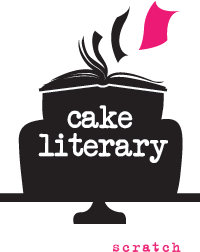
Remember last week how I blogged about book packagers and literary development companies? And I had a lot of questions with no real answers?
After the post ran, Sona Charaipotra and Dhonielle Clayton, the founders of CAKE Literary, got in touch with me and gave me the opportunity to ask some of those questions. Knowing how much the topic fascinated me, I couldn't say no -- and I thought readers who wanted to know some of the same things I did would find this of interest as well.
This post won't talk about how you get involved with the company. Rather, this is a look at their mission, why they decided to create a company, what their intentions are, how they plan on breaking into the market with diversity-focused titles, and it'll talk a bit about their first book -- published under the company -- called Dark Pointe. It is long, but I think it's really fascinating and quite thorough about their process.
What
are your backgrounds with publishing and the book/literary world more
broadly?
Sona Charaipotra:
I’ve worked as a journalist for more than a decade, first on-staff
at People
and
TeenPeople
magazines,
then freelance for places like the New
York Times,
MSN, Cosmopolitan,
ABC News and others. While doing that, for a long time, I was writing
screenplays -- I have a Masters in Dramatic Writing from NYU -- and
even had a few projects developed. My screenwriting background means
I’m definitely a plotter -- I’m a huge believer in three-act
structure. But I’ve also been writing fiction for a while, and
decided to get my MFA at the New School so I could really work on
honing craft and character. That’s where I met Dhonielle. These
days, in addition to working on books, I’m writing a lot about
them. In doing a column for Parade.com on teen and YA culture, I’ve
interviewed writers like Holly Black, Maggie Stiefvater and Rainbow
Rowell.
Dhonielle Clayton:
After I stopped teaching, I decided to get into publishing because
the one thing that drew me to secondary education was being able to
read and discuss books that I loved. So I worked at National
Geographic
in Washington, DC, in their children’s department, reviewing
non-fiction manuscripts aimed at children, as well as fiction series
with strong environmental themes aimed at school and library markets.
I did this while I was earning my first masters in Children’s
Literature. I joined SCBWI and started going to conferences and
learning all that I could about the market. After I finished that
degree, I knew I had to go to NYC if I wanted to really dig into the
publishing world, so I applied to The New School MFA program, where I
met Sona. I knew immediately that I wanted to intern for a NYC
publishing house or a literary agency. I moved to the city the summer
before the program started, crashed on one of my good friend’s
couches, and landed an internship working for Stephen Barbara at
Foundry Media. Working at Foundry Media is where I learned a lot
about the business. I also started attending all the readings in the
city that I could, and lurking around the NYC book scene in general.
What
made you decide to create a literary development company and what's
your vision for it?
SC:
I was a huge reader as kid -- books were my greatest
indulgence, and my mother always said that it was the one thing she’d
always let me buy, because it was money well-spent. The thing is, as
much as I loved to read, I never saw myself in the books I devoured
as a kid. There were no brown children to be found. These days,
reading to my daughter, who’s three, things aren’t all that
different. So I think it’s really important to bring diversity to
kid lit and teen fiction -- and to women’s fiction, too, because I
still don’t see that grown-up version of myself anywhere, really.
We’ve all got stories to tell. But the thing that really moved me
towards CAKE and literary development is the idea that while a book
can have a character of color at its center, it can still be an
entirely universal story. I see that in a lot of my own work, and in
Dhonielle’s, too.
Dhonielle
and I are definitely ideas people. We could work ceaselessly and
never be able to put out even a tenth of what we’re coming up with.
These are exciting, compelling stories -- worth telling -- and we
thought working with other writers would be a great way to get them
out there. To be clear, not every book we publish will have a black
or brown girl at its center. We’re focusing on meaningful diversity
-- layered in and relevant, but not the central thrust of the story.
These aren’t, “Oh, I’m Indian and so discriminated against”
types of tales. These are fresh, high concept stories where the
characters happen to be diverse. But we don’t shy away from what
race, class or ethnicity brings to the character, either. If it’s
relevant, it will be explored.
DC:
I have always been an avid reader. My father took me to the bookstore
every weekend. It was our Saturday routine. So I was a spoiled child
and received a brand new set of books every Saturday with the caveat
that I finished the ones I got the week prior. My childhood home was
full of books, and I gravitated towards the ones on my father’s
shelf -- Tolkien, Isaac Asimov, C.S. Lewis, and Frank Herbert. I
wanted to go through the wardrobe into Narnia or trample through
Middle Earth. However, no one who looked like me starred as the lead
in those stories (unless you wanted to be an orc, and nobody wants to
be one of those). After my masters at Hollins University, I knew I
had to do something about it. I started writing stories, and keeping
a journal of other ideas that I felt might enhance the genre. I knew
I would not be able to physically write all of these books, and I had
become loosely familiar with some packaged projects while completing
grad school papers.
When
I met Sona, our conversations kept circling back to seeing or not
seeing ourselves in books as kids. As an Indian-American, her plight
was worse than mine. I had never even met a fictional Indian kid in a
story myself. There are African-American children’s books. Due to
responsible parents, I had every one of them, but sometimes I felt
like I was reading the same story over and over again. The
conversations Sona and I had were the foundation for CAKE Literary,
and helped carve out the start of our mission.
We
want to present a different model of how diversity can be included in
children’s and teen books, and move away from the cultural tales
(e.g. grappling with one’s culture, race, ethnicity, historical
tales of slavery or other events that have “marked” a group,
etc). Don’t get me wrong, these narratives are important
cornerstones to the world of children’s and teen fiction. I
wouldn’t be who I am without them. They need to be published, read
and studied by children and teens. But after seeing Chiamanda
Adichie’s TED talk titled “The
Danger of a Single Story” ,
it crystallized the emotion I had had as a child: feeling trapped
inside one story related to my people. This sparked my fervor for
wanting to help transform the landscape of books for kids and teens.
I wanted to open up the single story that is often attached to
children of color, whether that be the legacy of slavery, the
Holocaust, life on the reservation, poverty, immigration, etc. I
wanted to give these children other stories, too: adventures to other
planets, girl drama at school, quests through foreign lands full of
magical beings, awkward first crushes. Sona and I felt like a
packaging company was the right vehicle to start developing projects
that have a new take on diversity, and model how all writers can
incorporate color into their novels.
What
does it mean to have a highly commercial novel that's also decidedly
literary (in other words, what sorts of books on the market now are
what you envision to be what your company aims to produce)?
SC:
There’s been so much talk about voice -- and that’s what we mean
here. It’s about creating work that’s very high concept -- you
get what the story is just in a line or two, then think, “Why
didn’t I think of that?” But we’re playing careful attention to
craft and voice. We’re a packager, but we want there to be nothing
slapdash about CAKE’s projects. We want them to be compellingly
readable, but we also want those specific lines to linger in your
mind long after you’ve finished the book. Fun fiction that stays
with you.
DC:
A book that is delicious and compulsively readable, but on a sentence
level is still beautiful. Many times commercial books are given flack
for being not well-written, but contain an amazing plot,
story-telling structure, or interesting characters. So books like Jay
Asher’s Thirteen
Reasons Why,
Lauren Oliver’s Delirium,
Lauren DeStefano’s The
Chemical Garden Trilogy,
and Jenny Han and Siobhan Vivian’s Burn
for Burn trilogy,
just to name a few. Sona and I want to create books that are smart,
contain beautiful storytelling in a very high concept idea -- with a
strong element of diversity.
What
is it about the MG, YA, and women's fiction markets that makes now a
time that companies like your own are emerging?
SC:
Everyone keeps talking about the YA boom. Of course it’s something
people want to capitalize on. And these days, so much of what we see
in teen fiction is what’s translating to television and film. It
makes sense, business-wise, to be in this market. But also, as I’ve
mentioned, there’s a stark lack of representation of certain types
of people in this market. There’s still the idea that books about
people of color don’t sell. And it’s because a lot of the books
we’ve seen before were very pedantic, very heavy-handed, with a
certain point to make and maybe an axe to grind. I think there’s
definitely a way to do diversity -- and I’m not talking about
shying away from the issues people of different races or orientations
or classes deal with -- but do it in a way that still makes it a
compelling, universal read. I think that’s what readers are looking
for -- that delicious story, but with people they recognize at the
center. Perhaps with a reflection of themselves at the center. That’s
something I never got as a kid, and I would have killed for it.
(Okay, maybe not killed...but you get my point!)
DC:
The MG, YA, and women’s fiction markets are HOT! Work created for
individuals who belong to these groups is dynamic, fresh, and
interesting. I can’t even tear myself away from those titles to
explore any other genres. There’s just too much to read. We want to
be part of that. Sona and I watch a lot of TV (alas, it is a my vice,
yet part of her career as a journalist), and we see the world of TV
slowly changing in terms of diversity, and we feel like books could
reflect this change as well. Who wouldn’t want to read a YA book
series like ABC Family’s Twisted,
The
Fosters, or
Switched
at Birth?
High-concept projects with meaningful diversity that create a
compulsive story. We want to add new elements to the market.
Your
focus is on diversity -- speak to that a bit and why you chose that
angle for CAKE? What does the market look like now and what do you
envision CAKE adding to it?
SC:
The scale is tipping. There’s still a long way to go, but these
days, there are more people of different creeds, colors, orientations
than ever in media -- in film, on TV, and hopefully now the push has
come in books. Yet there’s still consistently this talk of how
books with black girls on the cover won’t sell, how diversity isn’t
marketable. I think the idea is that color may alienate a white
reader. But it doesn’t have to. The key is to make the story
relatable, universal -- and un-put-down-able. That’s what we were
aiming for with DARK POINTE. The book centers on three very different
girls, one white, one Korean, and one black. And their races do play
into the character development and even plot, however, the story
doesn’t dwell on that. It’s own, fast-paced, compelling thing --
and there are elements about each of these girls that make them
relatable, no matter what your skin color. That’s what we’re
hoping to bring to CAKE projects -- stories you can’t not
read,
but with those layers of diversity hewn in. Make race, sexual
orientation, class relevant, but not the center of the story.
DC:
Sona and I are nothing if not meticulous, so before even stepping out
on this journey, we researched. Tons. We looked at all of the current
packagers in the YA and MG market, and read their books, interviews,
online information, etc. We spent a lot of time thinking about what
could/would make us different in this crowded market besides that
fact that we are underdogs without any of our own published books on
the shelf. There were so many reasons not to jump in, and there were
many people who told us not to: You
guys have no real experience in publishing.
Neither
of you have your own books out there yet.
Diversity
doesn’t sell well internationally.
But
then the heart of the company bubbled up naturally. We didn’t start
with diversity at the core from which we wrote DARK POINTE. It just
continued to come up over and over again. When we looked at the
novel, we realized the key was there. We envision that CAKE will add
solid titles to the market that open up new stories and provide a new
lens for thinking about diversity. It’s not a term to invoke guilt
or shame, but rather to inspire flavor. Everybody loves cake, and it
would be mighty boring if it only came in one flavor.

Going
off that, what is it that CAKE will be able to make happen that other
authors who have been writing diverse stories are less able to do?
SC:
CAKE -- like the other literary development companies out there -- is
all about the high-concept. That’s the big book with the big hook
-- the one with the concept that carries, the delicious read.
That’s what publishers want. The other element we’re adding here
is the component of diversity. We’re hoping -- and I think this
will be true -- that diversity will also be what publishers want in
the future. We think the time has come. The population is shifting.
Librarians and teachers are asking for them. Dhonielle can attest
from her background in a middle school library that children
themselves are asking for them. So combining these two elements --
high-concept and diversity -- is what makes our projects different.
It’s
about a big story with a fresh cast of characters from varied
backgrounds, with layers of storytelling. Essentially, what we’re
hoping is that what a publisher will see in a CAKE story, first and
foremost, is a delicious, irresistible page-turner they have to have.
And then they see all those other layers that add a lot of depth to
the work.
DC:
We don’t think other authors and aspiring writers who are writing
diverse stories can’t do what we’re doing. Authors like Sherman
Alexie, David Levithan, Jacqueline Woodson, and countless others,
have been adding wonderfully diverse titles to the canon for years.
They have done remarkable things for bringing diversity to the
children’s and teen book world. We believe that using the vehicle
of a literary packaging company may add an influx in the number of
titles published with diverse elements, and help shrink the gap a bit
faster. We’re just starting out, so we don’t think we’ll
balloon into a powerhouse like Alloy Entertainment, but if we did,
there would be more stories out there that featured all types of
children at a higher frequency than possible for a single author
writing one or two books per year. At least we hope so!
Talk
a bit about the first book to come from CAKE: Dark Pointe.
SC:
A fast-paced YA mystery in the vein of Pretty
Little Liars,
DARK
POINTE
digs beneath the practiced poise of a cutthroat Manhattan ballet
academy, where three young protagonists all fight for prima position
while navigating secrets, lies, and the pressure that comes with
being prodigies. Free-spirited new girl Giselle just wants to dance –
but the very act might kill her. Upper East Side-bred Bette lives in
the all-encompassing shadow of her ballet star sister, but the weight
of family expectations brings out a dangerous edge in her.
Perfectionist June forever stands in the wings as an understudy, but
now she’s willing to do whatever it takes – even push someone out
the way – to take the stage. In a world where every other dancer is
both friend and foe, the girls have formed the tenuous bond that
comes with being the best of the best. But when New York City Ballet
Conservatory newbie Giselle is cast as the lead in The
Nutcracker
– opposite Bette’s longtime love Alec – the competition turns
deadly.
DC:
This book came out of my experience as a secondary teacher at the
Kirov Academy of Ballet in Washington, DC, and Sona’s love of
ballet (we both danced till we were about 11) and TV coverage of
Pretty
Little Liars.
I taught the middle school and high school dancers English, after I
graduated from college.
What
makes this project stand out from the masses of other projects
compared to the juggernaut of Pretty
Little Liars
is the diversity, and the nuances of the ballet world. In initial
brainstorm meetings for the project, we didn’t sit down and say,
“Let’s add some meaningful diversity to this book.” I spent
hours remembering my time teaching at the Kirov Academy of Ballet of
Washington, DC, and making lists of details. I wanted our characters
to reflect the world there. The reality is that there are legions of
Asian dancers that haven’t showed up on the new ballet reality TV
shows like the CW’s Breaking
Pointe or
in documentaries about ballet, and the Misty Copelands of the world
have had a challenging path to success in the ballet world. We wanted
those honest layers in there alongside the universal story of girls
who want something so bad they’re willing to do whatever it takes
to get it.
Why
did you decide to pursue publication under the umbrella of CAKE
rather than as coauthors and an agent (in other words, why not the
"traditional" path)?
SC:
Dhonielle and I both met while pursuing our MFAs in Writing for
Children at the New School. There, we were both working on individual
projects -- and we still are. But we were always coming up with these
crazy, cool and really fun ideas for collaborations. DARK POINTE was
the first we thought had serious potential, and we decided to work on
it together, while still working on our own stuff, which is very
different. It likely won’t be the last collaboration for us, and we
had plenty of other solid ideas that we didn’t want to write
together. What we quickly discovered was that there was something
awesome that happened when you put us in a room together to
brainstorm -- a creative chemistry, an alchemy of sorts. We both have
different strengths -- I am partial to the three-act structure and
plotting, while D is the world-builder -- and we work well together.
We
didn’t want to let all those ideas just fester. So we decided --
based on what we’d seen in the industry of boutique packagers --
that maybe this would be something for us to look into. After careful
planning, we decided we’d pursue this type of publication and
launch this company, alongside working on our individual projects. In
writing DARK POINTE together, we realized it was the perfect first
project for such a venture, and would embody everything we’re
about.
Thanks for sharing your own insights on book packagers and literary development, Sona and Dhonielle.







 Related StoriesA Closer Look at The New York Times YA Bestsellers List, Part 2A Closer Look at The New York Times YA Bestsellers List, Part 1The In-Between by Barbara Stewart
Related StoriesA Closer Look at The New York Times YA Bestsellers List, Part 2A Closer Look at The New York Times YA Bestsellers List, Part 1The In-Between by Barbara Stewart
Published on November 05, 2013 22:00
November 4, 2013
A Closer Look at The New York Times YA Bestsellers List, Part 2
* This is part two of a two-part series.
If you haven't spent time with yesterday's data, you should do that before diving into today's post. This is quite a bit shorter, though it's got far fewer images. Today I wanted to look at the publishers who are represented on the NYT YA List, as well as talk about what the list looks like now that Veronica Roth has jumped to series. I've also got a few concluding thoughts and observations I thought were worth sharing at the end.
Publishers Represented on the NYT YA List
I'm always curious whether there's one publisher which has more books landing on the bestseller list than others. Part of this stems from the idea that perhaps a bigger marketing push is why those books get on the list in the first place and then continued push on titles which maintain their spots over a lengthy period of time. I think, too, it's interesting to keep this in mind with the rise of very cheap and short-term ebook sales and what impact those may have on books which then appear or stick around on the list. Because it's not price that gets books on the list; it's sales numbers.
Because I am human and because counting up the appearance of publishers on a list, I know I made a little bit of a counting misstep. I looked at 47 lists total, which included the extended books -- leaving out the list where Veronica Roth has moved over to series -- and there should be a total of 705 books to tally. But in my final numbers, I missed a few and ended up with a count of only 701 books. So, I've taken the liberty and rounded the biggest numbers by publisher up to the nearest 0 or 5, for simplicity's sake. It did not impact the results.
I've flattened the publishers, folding all of the imprints within their bigger houses. In other words, Tor books and St. Martin's books are counted under Macmillan. Because Penguin and Random House are still appearing as separate houses, I kept them as separate in my tally.
On the 47 weeks worth of lists, a total of 12 publishers are represented. They break down as follows:
Penguin: 295 booksHarper Collins: 140 booksSimon & Schuster: 70 booksRandom House: 60 booksHachette/Little, Brown: 45 booksMacmillan: 45 booksQuirk: 45 booksScholastic: 7 booksDisney: 6 booksBloomsbury: 2 booksHoughton Mifflin Harcourt: 1 bookNicole Reed Books: 1 bookAs I noted in yesterday's post, I have no idea why a self-published "new adult" title got onto the NYT List. Human error is the most likely reason, which I'll talk about in the next section.
It's interesting to see that, without doubt, Penguin dominates with titles on the bestsellers list. Worth noting: Penguin publishes John Green, Rick Yancey, and Sarah Dessen, all of whom spent some time on the list. Harper publishes Roth's series, Random House publishes The Book Thief, and Simon & Schuster publishes Perks of Being a Wallflower. Quirk publishes Miss Peregrine's Home for Peculiar Children.
If you're curious about those smaller numbers: HMH published Dark Triumph which was on the list for one week, and Bloomsbury published Falling Kingdoms and S. J. Maas's Crown of Midnight.
E-Book Originals, The Definition of "Series," and Defining "YA"
I talked a bit yesterday about e-books and the impact of e-book sales on the appearance of titles on the list. What I didn't talk about was that a number of e-originals have themselves made the list. These are books which are not in print but only exist in a digital format. This tells us a number of things about the buyers of these books, as well as about what those appearances may say in terms of who or what influences the books that do appear on the list. Or maybe more, who or what influences the titles which last on the list more than a week or two.
The e-book originals -- short stories, it should be noted -- that have appeared on the list include two of the Cassie Clare co-written titles in the "Bane Chronicles" series: "What Really Happened in Peru" and "The Runaway Queen."
Kiera Cass's "The Prince," which was also an e-original short story, appeared on the list as well.
The reason I wanted to point these out is because, as noted yesterday, books jump to the series list after there are three titles published within that series. So the publication of Allegiant meant that Roth moved from the YA list onto the series list. But interestingly, this hasn't always been the case with YA books, and it's been inconsistent.
Taherhi Mafi's "Shatter Me" series made the series list this year, despite the fact the third book within that series has yet to be published. Rather than have potentially two spots on the YA list, the books were instead grouped onto the series list. And the reason? The publication of an e-original titled "Destroy Me."
By that theory, Cass's books should have jumped to the series list with the publication of The Elite, which came after The Selection and "The Prince." But it didn't.
There is clearly some inconsistency and human error going on with the definition of series and it does play a role in what is and is not ending up on the YA list. Had Mafi's books ended up on the YA List, rather than the series list, perhaps there would have been a week or two where women had more spots than men did. But we'll never know because when the final book in her series does publish, it'll definitely be on the series list.
Another thing that interests me on the YA List is how the creators define "YA." As noted previously, two "new adult" authors have made the list: Nicole Reed and Abbi Glines. Both of their books are published for the 17 and older audience, which is spelled out right in the listing about the book on the list. This is an interesting -- and frustrating -- tactic used to get those books on the list meant for books published for the 12-18 market. Would those books stand a chance on the much more crowded adult list, were they listed as being for those 18 and older instead of those 17 and older? How blurry do we allow the lines between YA and not-YA to get, especially when it comes to something as influential as the bestsellers list? And, if we are going to have something called "new adult" fiction, then can we fairly give them a space on the YA list if it's something completely all its own?
There is a lot to dig into here when it comes to readership and buyership. Those e-originals aren't getting their sales through traditional means. I want to know who is buying them. My bet is on teenagers who are devoted fans to the series -- which then would tie into my previous comments about teen influence on the list being why those titles appear once or twice and then disappear. I suspect, too, the e-original format severely limits long-term readership and audience reach.
The Post-Roth List
Part of my curiosity about gender and the NYT List came because I knew that Veronica Roth's "Divergent" series moving over to the series list would open up two spots. Would they allow more women in? Or would more men have the chance to land on the list? What would her two spots -- which have been there since week one -- do to the average length of stay for male-written vs. female-written change dramatically now that her two books with 47-week histories are gone?
So far, there has only been one list to look at to think about these questions. But the list that came out when her books went to the series list looks . . . remarkably like every other list so far. No surprises. No one new. Nothing out of left field.
On this week 48 list, the stats broke down as such:
9 men total were on the list 12 books written by men were on the listWithin the top ten, 6 males were on the listWithin the top ten, 8 books written by men were on the list. The average length of stay for these 12 male-written book on the NYT List for week 48 -- the first one after Roth's series shifted -- was 32 weeks.
More stats about this list:
3 women total were on the list3 books written by women were on the listWithin the top ten, 2 females were on the listWithin the top ten, 2 books written by females were on the list.
The average length of stay for these 3 female-written books on the NYT List for week 48? Five Weeks.
Because doing an average of overall length of stay across genders would be silly with only this one week post-Roth to compare, this is a number to still think about. The average length of stay for books on the week 48 list for men is 32. Women, 5. This is going to make a difference the further out we go from here, as I predicted yesterday. It will matter.
The two women who were in the top ten were Marie Lu and Lauren Kate. As you likely know, Marie Lu's series wraps up in November and she, too, will shift over to the series list. This will leave one -- maybe two -- spots open for new faces on the list. More than that, it'll lower the average length of stay for a female-written book on the NYT List even further down.
We'll see if Lauren Kate's book will remain on the list. It debuted at #6, so even if Roth's books remained on the standard list, it's likely Kate's title would have made it on the list. But this list reflects the sales the week Kate's book came out, so it's worth keeping an eye on whether this one has staying power or if it reflects many of the other books which debut on the list one week and slide off the week or two next. Again, and this is all hypothesis, but perhaps those books represent high sales by the actual teen contingent, as they're books teens are eager and excited about as soon as they are published (which isn't to say those books don't remain popular, but rather, they don't sustain the same level of sales in the weeks after initial launch).
If you're curious about publisher representation on the post-Roth list, I've got that for you, too:
Penguin: 5 books Random House: 4 booksHachette/Little, Brown: 3 booksSimon & Schuster: 1 bookMacmillan: 1 bookQuirk: 1 bookThere was not a single book from Harper Collins on the list after Roth's series moved over.
Other Observations
I thought I'd wrap up all of this data, commentary, and totally speculation with some of the interesting trends and ties that didn't fit neatly into another category but were still worth thinking about. So this will potentially be a little messy and again, no graphics.
First: what were the total representations by gender on the list? This does include the numbers for the Post-Roth list and does include the extended list.
Males: 17Females: 33Of those:Four male authors had multiple books on the NYT List. These were John Green, James Patterson, Brandon Sanderson, and David Levithan.Twelve female authors had multiple books on the NYT List. These were Veronica Roth, Maggie Stiefvater, Sarah Dessen, Ruta Sepetys, Marie Lu, Ellen Hopkins, Cassie Clare, Marissa Meyer, Maureen Johnson, Kiera Cass, Rainbow Rowell, and Gayle Forman.
Finally, I'd noted that there's a trend for books to end up on the list one week then fall off, particularly for female authors. I took some notes on trends I saw in terms of books that didn't last more than 2 weeks on the top ten list (or extended list) and thought they were worth sharing. This is very raw and it's quite likely I've overlooked something here, but the trends are worth paying attention to.
Female-authored books which lasted only one week on the top ten before either falling off the list completely or falling onto the extended list.
Endless Knight by Kressley Cole: Debuted at #6, fell off entirely the following week.Battle Magic by Tamora Piece: Debuted at #8, fell off entirely the following week.If I Stay by Gayle Forman: Debuted on list at #6, fell off but returned later on in the 47 weeks I looked at.Just One Year by Gayle Forman: Landed on the extended for one week, then disappeared.Seige and Storm by Leigh Bardugo: Landed on extended for one week, then disappeared.Of Triton by Anna Banks: Landed on extended for one week, the disappeared."The Runaway Queen" by Cassie Clare and Maureen Johnson: Debuted at #8, then disappeared. Never Fade by Alexandra Bracken: Debuted at #10 the week before Roth's book moved over, but on the list following Roth's shift, it fell off. Darkest Minds by Alexandra Bracken: Debuted on extended the week before Roth's book moved over, nut on the week following Roth's shift, it fell off. "What Really Happened in Peru" by Cassie Clare and Sarah Rees Brennan: Debuted at #4, then disappeared. Dark Triumph by Robin LaFevers: Debuted at #9, then disappeared. Out of the Easy by Ruta Sepetys: Debuted on the extended, then disappeared.Ruining You by Nicole Reed: Debuted at #9, then disappeared. "The Prince" by Kiera Cass: Debuted #6, then disappeared. The Madness Underneath by Maureen Johnson: Debuted #6, then disappeared. Etiquette & Espionage by Gail Carriger: Debuted #9, then disappeared. Falling Kingdoms by Morgan Rhodes: Debuted on extended, then disappeared. Seraphina by Rachel Hartman: Debuted on extended, then disappeared.Compare that number of titles to the number of titles written by men which appeared on the list once before disappearing:
Unnatural Creatures by Neil Gaiman: Debuted on extended, then disappeared.I Hunt Killers by Barry Lyga: Debuted #2, then disappeared. Shipbreaker by Paulo Bacigalupi: Debuted on extended, then disappeared.
My counts show that as 17 women have lasted on week before disappearing (I did not count Forman's If I Stay since it did come back) and only 3 men who have lasted just one week before disappearing.
I should note there was a comment on yesterday's post that shed some insight into this phenomenon -- Maggie Stiefvater pointed out the pre-order factor playing into books landing for a week and then falling off. So there's that consideration, and that plays into a whole additional series of questions that I'm not even touching on here but would love to see explored.
Where to Go From Here
There are a million avenues of exploration. And I welcome other people to spend the time to look into them. I'd love to know how the series list looks when broken down. I'd love to see how the NYT List stacks up against other measures of "success" -- the BookScan numbers, the USA Today list, end-of-year "Best of" lists, and so on and so forth.
I caution anyone considering looking at these things to understand this isn't easy to parse out or dive into. This is time-consuming stuff, and there are a lot of implications and considerations to have. You can't "simply" count up the number of men and women who have had a book published within a year to discuss the notion of "dominance" within the field. That's just counting. There are far bigger things that impact what dominance and acclaim and prestige are.
There is not one single thing that can be pointed to as the problem nor one single thing that can be pointed to as a solution. And to devalue the meaning of The New York Times Bestseller List as simply something "faulty" or "broken" is to make a grandiose statement about the impact it has in sales, marketing, publicity and not to mention word-of-mouth, the general public, and those who write the books. A system may be broken but it doesn't mean it holds less merit in the eyes of those who give it merit.
I want to see more discussion of this. I want to see more hard numbers -- but it takes time. I want to look at (and plan to with some time and energy) other distinctions within the book world, including things such as the distribution of starred reviews against gender. Do we tend to see male-written books as more literary than those written by females? I'd love to see someone tackle questions that popped up, too, about the differences in marketing budgets for male vs. female written titles. And of course, there's the question of gender of the main character of these novels, too -- though I think that is a much tricker, assumptive measure, particularly when you look at it against the NYT List. You're suggesting something about readership, rather than you are about prestige. There's nothing wrong about that, and indeed, there's something really fascinating to dig out there. But it is not in any way the same thing.
Maybe someplace worth starting would be rounding up posts that tackle the issue of gender and YA and doing a meta-analysis. Go look at Lady Business's posts about gender in the awards lists. Look at the post that came after NPR's "Best YA Ever" list. Casey Wilson looked at the breakdown of gender on the NYT List prior to it being split into different categories and that's more than worth a look. Go look at other posts that have explored gender and any sort of recognition (I've written a few myself). Might as well also check out Calling Caldecott's post about gender disparity with the Caldecott at The Horn Book, too.
This stuff exists and has been talked about for a while now. Perhaps a deep exploration of what's already out there will show where there are holes. It may also allow a bigger appreciation of how much discussion of this topic has happened.
This is not new.
Final Thoughts
Of course, nothing is conclusive here, except that there is in no way a female domination in YA, at least when it comes to what's perceived as being "the best" in this category. The numbers show again and again men hold more places on the list and have the entire time there has been a separate YA list.
It would be interesting to look at the series list and see if this trend remains or changes. It'd also be interesting to look at other best-of lists and see where gender lines up (I've done that on the yearly "best" roundups, and I do plan on doing it again this year when all of those lists appear).
Keeping an eye on the list now that Roth is off is something I want to do because I'll be curious what happens over the next six months. Will more women appear on the list? Will they last there very long? Or will the list remain essentially the same as it is now, primarily men who have been holding those spots for a very long time. It'd be interesting -- though challenging -- to look, too, at who has relationships with who on those very lists and what influence that might have on books that appear again and again and those which don't. A book that gets, say, a John Green blurb or review in a well-respected newspaper have a better chance of getting on the list and lasting there? Will more publishers reduce books in e-format for a very short period to get an author on the list in time for whatever their next release may be?
The List gives such a minuscule view of the YA world at large, and it is revered one of the most, if not THE most, prestigious places to be because of that. But it's too bad that even that prestige comes with the now-disproven suggestion that women dominate the YA world. They don't. Men do -- at least when it comes to what many see as what "matters" because it's "best."
Responses to Yesterday's Discussion
This section wasn't in my initial post, but I feel compelled to add it.
I was blown away by the response to yesterday's post, and I'm grateful for everyone who read it and took the time to think about it and discuss it.
But I want to point you all specifically to a very interesting -- and very touchy -- conversation that took place on Twitter about gender and the List. This happened between E. Lockhart, Maureen Johnson, Maggie Stiefvater, and John Green. Go read. Then come back.
Let's pick this apart just a little bit. I don't want to lead into too much of what it means or suggests because I think it's fairly evident. But what stands out to me are the following points:
1. Green's comment that we need to accept this is happening and "begin a conversation about why."
There is no "beginning" this conversation. It has been on going for a long, long time. But it's interesting that the moment a male steps in to the gender conversation, it's a beginning. Just because someone decides to enter a conversation, doesn't mean it's the beginning of a conversation.
2. Lockhart's suggestion that hetero lady librarians buy books because of good looking men.
I have to say it flat out: this actually offended me on a personal level, as a librarian myself. And seeing it from an author who benefits from the skills and work librarians do made it even rough to see. It so devalues the hard work and knowledge and dedication to doing our jobs well. It undermines how much we put into serving our communities and connecting our communities to the books they want to have.
Further, seeing that from an author who has written such amazingly feminist novels is utterly disheartening.
While it was most likely a mis-typed sentiment, I saw it, and I know many, many other librarians saw it. And many were not happy about it. It only further plays into some hugely problematic gender schematics -- and as they relate to one's professional affairs.
3. Green's suggestion that by not being a top ten selling author in the country he's not privileged.
Green's been on the NYT Bestsellers list for 47 weeks, with multiple books. Green is in a very elite, VERY RARE, set of the 1% of YA authors out there. He have never not received some acknowledgment of his work.
This isn't to say he isn't talented -- CLEARLY he is. Absolutely no one would ever argue that, nor should they. He's earned it!
But being unable to assess one's own privilege and reducing it to a comparison of another "bestselling" measure is derailing the bigger point.
4. Green's offense on behalf of another author who has benefitted from his voice and platform.
Were his platform, fandom, and voice not seen as valuable and profitable and worth pursuing in the YA world, then people wouldn't clamor for a review from him nor a blurb from him. Green blurbs and reviews very few books -- fewer still in a lengthy column in The New York Times -- and it would be silly not to see that as beneficial to any author who receives it, ESPECIALLY when that blurb is used again and again in future promotions for the author who received it.
This is a place of privilege. There is nothing wrong with that. But there is something to be said about understanding that privilege and value of voice.
This was never, EVER about a single book he wrote a review for. It's about the value of his voice as it helped propel a woman's work into a wider audience. As I noted in the comments on yesterday's post, his blurb on E Lockhart's forthcoming book is big and bright. There's no question that is a selling point to the book -- so much so that Random House tweeted about it.
And so I revert to the question I keep wondering about: how much does a revered male's voice help a female's career? When a man who is seen as someone with power and authority within a field -- be it the YA world, the librarianship world, the teaching world, the publishing world, the corporate world, and so on and so on -- why is it his word is what can make (or break) a woman's chances in that same field? What is it that allows him continued authority and respect? And hell, he doesn't necessarily even need to be revered. It's likely having a male voice is enough to help a lady out in many, many places.
This isn't just about John Green. It's about gender on a much huger scale.
It is clear there is an issue to discuss here, and I am so glad it's bring discussed.
But it should also be clear that in discussing this issue, there are even messier, sometimes more problematic, knots to untangle.






 Related StoriesA Closer Look at The New York Times YA Bestsellers List, Part 1The In-Between by Barbara StewartAudiobook Review: The Waking Dark by Robin Wasserman
Related StoriesA Closer Look at The New York Times YA Bestsellers List, Part 1The In-Between by Barbara StewartAudiobook Review: The Waking Dark by Robin Wasserman
If you haven't spent time with yesterday's data, you should do that before diving into today's post. This is quite a bit shorter, though it's got far fewer images. Today I wanted to look at the publishers who are represented on the NYT YA List, as well as talk about what the list looks like now that Veronica Roth has jumped to series. I've also got a few concluding thoughts and observations I thought were worth sharing at the end.
Publishers Represented on the NYT YA List
I'm always curious whether there's one publisher which has more books landing on the bestseller list than others. Part of this stems from the idea that perhaps a bigger marketing push is why those books get on the list in the first place and then continued push on titles which maintain their spots over a lengthy period of time. I think, too, it's interesting to keep this in mind with the rise of very cheap and short-term ebook sales and what impact those may have on books which then appear or stick around on the list. Because it's not price that gets books on the list; it's sales numbers.
Because I am human and because counting up the appearance of publishers on a list, I know I made a little bit of a counting misstep. I looked at 47 lists total, which included the extended books -- leaving out the list where Veronica Roth has moved over to series -- and there should be a total of 705 books to tally. But in my final numbers, I missed a few and ended up with a count of only 701 books. So, I've taken the liberty and rounded the biggest numbers by publisher up to the nearest 0 or 5, for simplicity's sake. It did not impact the results.
I've flattened the publishers, folding all of the imprints within their bigger houses. In other words, Tor books and St. Martin's books are counted under Macmillan. Because Penguin and Random House are still appearing as separate houses, I kept them as separate in my tally.
On the 47 weeks worth of lists, a total of 12 publishers are represented. They break down as follows:
Penguin: 295 booksHarper Collins: 140 booksSimon & Schuster: 70 booksRandom House: 60 booksHachette/Little, Brown: 45 booksMacmillan: 45 booksQuirk: 45 booksScholastic: 7 booksDisney: 6 booksBloomsbury: 2 booksHoughton Mifflin Harcourt: 1 bookNicole Reed Books: 1 bookAs I noted in yesterday's post, I have no idea why a self-published "new adult" title got onto the NYT List. Human error is the most likely reason, which I'll talk about in the next section.
It's interesting to see that, without doubt, Penguin dominates with titles on the bestsellers list. Worth noting: Penguin publishes John Green, Rick Yancey, and Sarah Dessen, all of whom spent some time on the list. Harper publishes Roth's series, Random House publishes The Book Thief, and Simon & Schuster publishes Perks of Being a Wallflower. Quirk publishes Miss Peregrine's Home for Peculiar Children.
If you're curious about those smaller numbers: HMH published Dark Triumph which was on the list for one week, and Bloomsbury published Falling Kingdoms and S. J. Maas's Crown of Midnight.
E-Book Originals, The Definition of "Series," and Defining "YA"
I talked a bit yesterday about e-books and the impact of e-book sales on the appearance of titles on the list. What I didn't talk about was that a number of e-originals have themselves made the list. These are books which are not in print but only exist in a digital format. This tells us a number of things about the buyers of these books, as well as about what those appearances may say in terms of who or what influences the books that do appear on the list. Or maybe more, who or what influences the titles which last on the list more than a week or two.
The e-book originals -- short stories, it should be noted -- that have appeared on the list include two of the Cassie Clare co-written titles in the "Bane Chronicles" series: "What Really Happened in Peru" and "The Runaway Queen."
Kiera Cass's "The Prince," which was also an e-original short story, appeared on the list as well.
The reason I wanted to point these out is because, as noted yesterday, books jump to the series list after there are three titles published within that series. So the publication of Allegiant meant that Roth moved from the YA list onto the series list. But interestingly, this hasn't always been the case with YA books, and it's been inconsistent.
Taherhi Mafi's "Shatter Me" series made the series list this year, despite the fact the third book within that series has yet to be published. Rather than have potentially two spots on the YA list, the books were instead grouped onto the series list. And the reason? The publication of an e-original titled "Destroy Me."
By that theory, Cass's books should have jumped to the series list with the publication of The Elite, which came after The Selection and "The Prince." But it didn't.
There is clearly some inconsistency and human error going on with the definition of series and it does play a role in what is and is not ending up on the YA list. Had Mafi's books ended up on the YA List, rather than the series list, perhaps there would have been a week or two where women had more spots than men did. But we'll never know because when the final book in her series does publish, it'll definitely be on the series list.
Another thing that interests me on the YA List is how the creators define "YA." As noted previously, two "new adult" authors have made the list: Nicole Reed and Abbi Glines. Both of their books are published for the 17 and older audience, which is spelled out right in the listing about the book on the list. This is an interesting -- and frustrating -- tactic used to get those books on the list meant for books published for the 12-18 market. Would those books stand a chance on the much more crowded adult list, were they listed as being for those 18 and older instead of those 17 and older? How blurry do we allow the lines between YA and not-YA to get, especially when it comes to something as influential as the bestsellers list? And, if we are going to have something called "new adult" fiction, then can we fairly give them a space on the YA list if it's something completely all its own?
There is a lot to dig into here when it comes to readership and buyership. Those e-originals aren't getting their sales through traditional means. I want to know who is buying them. My bet is on teenagers who are devoted fans to the series -- which then would tie into my previous comments about teen influence on the list being why those titles appear once or twice and then disappear. I suspect, too, the e-original format severely limits long-term readership and audience reach.
The Post-Roth List
Part of my curiosity about gender and the NYT List came because I knew that Veronica Roth's "Divergent" series moving over to the series list would open up two spots. Would they allow more women in? Or would more men have the chance to land on the list? What would her two spots -- which have been there since week one -- do to the average length of stay for male-written vs. female-written change dramatically now that her two books with 47-week histories are gone?
So far, there has only been one list to look at to think about these questions. But the list that came out when her books went to the series list looks . . . remarkably like every other list so far. No surprises. No one new. Nothing out of left field.
On this week 48 list, the stats broke down as such:
9 men total were on the list 12 books written by men were on the listWithin the top ten, 6 males were on the listWithin the top ten, 8 books written by men were on the list. The average length of stay for these 12 male-written book on the NYT List for week 48 -- the first one after Roth's series shifted -- was 32 weeks.
More stats about this list:
3 women total were on the list3 books written by women were on the listWithin the top ten, 2 females were on the listWithin the top ten, 2 books written by females were on the list.
The average length of stay for these 3 female-written books on the NYT List for week 48? Five Weeks.
Because doing an average of overall length of stay across genders would be silly with only this one week post-Roth to compare, this is a number to still think about. The average length of stay for books on the week 48 list for men is 32. Women, 5. This is going to make a difference the further out we go from here, as I predicted yesterday. It will matter.
The two women who were in the top ten were Marie Lu and Lauren Kate. As you likely know, Marie Lu's series wraps up in November and she, too, will shift over to the series list. This will leave one -- maybe two -- spots open for new faces on the list. More than that, it'll lower the average length of stay for a female-written book on the NYT List even further down.
We'll see if Lauren Kate's book will remain on the list. It debuted at #6, so even if Roth's books remained on the standard list, it's likely Kate's title would have made it on the list. But this list reflects the sales the week Kate's book came out, so it's worth keeping an eye on whether this one has staying power or if it reflects many of the other books which debut on the list one week and slide off the week or two next. Again, and this is all hypothesis, but perhaps those books represent high sales by the actual teen contingent, as they're books teens are eager and excited about as soon as they are published (which isn't to say those books don't remain popular, but rather, they don't sustain the same level of sales in the weeks after initial launch).
If you're curious about publisher representation on the post-Roth list, I've got that for you, too:
Penguin: 5 books Random House: 4 booksHachette/Little, Brown: 3 booksSimon & Schuster: 1 bookMacmillan: 1 bookQuirk: 1 bookThere was not a single book from Harper Collins on the list after Roth's series moved over.
Other Observations
I thought I'd wrap up all of this data, commentary, and totally speculation with some of the interesting trends and ties that didn't fit neatly into another category but were still worth thinking about. So this will potentially be a little messy and again, no graphics.
First: what were the total representations by gender on the list? This does include the numbers for the Post-Roth list and does include the extended list.
Males: 17Females: 33Of those:Four male authors had multiple books on the NYT List. These were John Green, James Patterson, Brandon Sanderson, and David Levithan.Twelve female authors had multiple books on the NYT List. These were Veronica Roth, Maggie Stiefvater, Sarah Dessen, Ruta Sepetys, Marie Lu, Ellen Hopkins, Cassie Clare, Marissa Meyer, Maureen Johnson, Kiera Cass, Rainbow Rowell, and Gayle Forman.
Finally, I'd noted that there's a trend for books to end up on the list one week then fall off, particularly for female authors. I took some notes on trends I saw in terms of books that didn't last more than 2 weeks on the top ten list (or extended list) and thought they were worth sharing. This is very raw and it's quite likely I've overlooked something here, but the trends are worth paying attention to.
Female-authored books which lasted only one week on the top ten before either falling off the list completely or falling onto the extended list.
Endless Knight by Kressley Cole: Debuted at #6, fell off entirely the following week.Battle Magic by Tamora Piece: Debuted at #8, fell off entirely the following week.If I Stay by Gayle Forman: Debuted on list at #6, fell off but returned later on in the 47 weeks I looked at.Just One Year by Gayle Forman: Landed on the extended for one week, then disappeared.Seige and Storm by Leigh Bardugo: Landed on extended for one week, then disappeared.Of Triton by Anna Banks: Landed on extended for one week, the disappeared."The Runaway Queen" by Cassie Clare and Maureen Johnson: Debuted at #8, then disappeared. Never Fade by Alexandra Bracken: Debuted at #10 the week before Roth's book moved over, but on the list following Roth's shift, it fell off. Darkest Minds by Alexandra Bracken: Debuted on extended the week before Roth's book moved over, nut on the week following Roth's shift, it fell off. "What Really Happened in Peru" by Cassie Clare and Sarah Rees Brennan: Debuted at #4, then disappeared. Dark Triumph by Robin LaFevers: Debuted at #9, then disappeared. Out of the Easy by Ruta Sepetys: Debuted on the extended, then disappeared.Ruining You by Nicole Reed: Debuted at #9, then disappeared. "The Prince" by Kiera Cass: Debuted #6, then disappeared. The Madness Underneath by Maureen Johnson: Debuted #6, then disappeared. Etiquette & Espionage by Gail Carriger: Debuted #9, then disappeared. Falling Kingdoms by Morgan Rhodes: Debuted on extended, then disappeared. Seraphina by Rachel Hartman: Debuted on extended, then disappeared.Compare that number of titles to the number of titles written by men which appeared on the list once before disappearing:
Unnatural Creatures by Neil Gaiman: Debuted on extended, then disappeared.I Hunt Killers by Barry Lyga: Debuted #2, then disappeared. Shipbreaker by Paulo Bacigalupi: Debuted on extended, then disappeared.
My counts show that as 17 women have lasted on week before disappearing (I did not count Forman's If I Stay since it did come back) and only 3 men who have lasted just one week before disappearing.
I should note there was a comment on yesterday's post that shed some insight into this phenomenon -- Maggie Stiefvater pointed out the pre-order factor playing into books landing for a week and then falling off. So there's that consideration, and that plays into a whole additional series of questions that I'm not even touching on here but would love to see explored.
Where to Go From Here
There are a million avenues of exploration. And I welcome other people to spend the time to look into them. I'd love to know how the series list looks when broken down. I'd love to see how the NYT List stacks up against other measures of "success" -- the BookScan numbers, the USA Today list, end-of-year "Best of" lists, and so on and so forth.
I caution anyone considering looking at these things to understand this isn't easy to parse out or dive into. This is time-consuming stuff, and there are a lot of implications and considerations to have. You can't "simply" count up the number of men and women who have had a book published within a year to discuss the notion of "dominance" within the field. That's just counting. There are far bigger things that impact what dominance and acclaim and prestige are.
There is not one single thing that can be pointed to as the problem nor one single thing that can be pointed to as a solution. And to devalue the meaning of The New York Times Bestseller List as simply something "faulty" or "broken" is to make a grandiose statement about the impact it has in sales, marketing, publicity and not to mention word-of-mouth, the general public, and those who write the books. A system may be broken but it doesn't mean it holds less merit in the eyes of those who give it merit.
I want to see more discussion of this. I want to see more hard numbers -- but it takes time. I want to look at (and plan to with some time and energy) other distinctions within the book world, including things such as the distribution of starred reviews against gender. Do we tend to see male-written books as more literary than those written by females? I'd love to see someone tackle questions that popped up, too, about the differences in marketing budgets for male vs. female written titles. And of course, there's the question of gender of the main character of these novels, too -- though I think that is a much tricker, assumptive measure, particularly when you look at it against the NYT List. You're suggesting something about readership, rather than you are about prestige. There's nothing wrong about that, and indeed, there's something really fascinating to dig out there. But it is not in any way the same thing.
Maybe someplace worth starting would be rounding up posts that tackle the issue of gender and YA and doing a meta-analysis. Go look at Lady Business's posts about gender in the awards lists. Look at the post that came after NPR's "Best YA Ever" list. Casey Wilson looked at the breakdown of gender on the NYT List prior to it being split into different categories and that's more than worth a look. Go look at other posts that have explored gender and any sort of recognition (I've written a few myself). Might as well also check out Calling Caldecott's post about gender disparity with the Caldecott at The Horn Book, too.
This stuff exists and has been talked about for a while now. Perhaps a deep exploration of what's already out there will show where there are holes. It may also allow a bigger appreciation of how much discussion of this topic has happened.
This is not new.
Final Thoughts
Of course, nothing is conclusive here, except that there is in no way a female domination in YA, at least when it comes to what's perceived as being "the best" in this category. The numbers show again and again men hold more places on the list and have the entire time there has been a separate YA list.
It would be interesting to look at the series list and see if this trend remains or changes. It'd also be interesting to look at other best-of lists and see where gender lines up (I've done that on the yearly "best" roundups, and I do plan on doing it again this year when all of those lists appear).
Keeping an eye on the list now that Roth is off is something I want to do because I'll be curious what happens over the next six months. Will more women appear on the list? Will they last there very long? Or will the list remain essentially the same as it is now, primarily men who have been holding those spots for a very long time. It'd be interesting -- though challenging -- to look, too, at who has relationships with who on those very lists and what influence that might have on books that appear again and again and those which don't. A book that gets, say, a John Green blurb or review in a well-respected newspaper have a better chance of getting on the list and lasting there? Will more publishers reduce books in e-format for a very short period to get an author on the list in time for whatever their next release may be?
The List gives such a minuscule view of the YA world at large, and it is revered one of the most, if not THE most, prestigious places to be because of that. But it's too bad that even that prestige comes with the now-disproven suggestion that women dominate the YA world. They don't. Men do -- at least when it comes to what many see as what "matters" because it's "best."
Responses to Yesterday's Discussion
This section wasn't in my initial post, but I feel compelled to add it.
I was blown away by the response to yesterday's post, and I'm grateful for everyone who read it and took the time to think about it and discuss it.
But I want to point you all specifically to a very interesting -- and very touchy -- conversation that took place on Twitter about gender and the List. This happened between E. Lockhart, Maureen Johnson, Maggie Stiefvater, and John Green. Go read. Then come back.
Let's pick this apart just a little bit. I don't want to lead into too much of what it means or suggests because I think it's fairly evident. But what stands out to me are the following points:
1. Green's comment that we need to accept this is happening and "begin a conversation about why."
There is no "beginning" this conversation. It has been on going for a long, long time. But it's interesting that the moment a male steps in to the gender conversation, it's a beginning. Just because someone decides to enter a conversation, doesn't mean it's the beginning of a conversation.
2. Lockhart's suggestion that hetero lady librarians buy books because of good looking men.
I have to say it flat out: this actually offended me on a personal level, as a librarian myself. And seeing it from an author who benefits from the skills and work librarians do made it even rough to see. It so devalues the hard work and knowledge and dedication to doing our jobs well. It undermines how much we put into serving our communities and connecting our communities to the books they want to have.
Further, seeing that from an author who has written such amazingly feminist novels is utterly disheartening.
While it was most likely a mis-typed sentiment, I saw it, and I know many, many other librarians saw it. And many were not happy about it. It only further plays into some hugely problematic gender schematics -- and as they relate to one's professional affairs.
3. Green's suggestion that by not being a top ten selling author in the country he's not privileged.
Green's been on the NYT Bestsellers list for 47 weeks, with multiple books. Green is in a very elite, VERY RARE, set of the 1% of YA authors out there. He have never not received some acknowledgment of his work.
This isn't to say he isn't talented -- CLEARLY he is. Absolutely no one would ever argue that, nor should they. He's earned it!
But being unable to assess one's own privilege and reducing it to a comparison of another "bestselling" measure is derailing the bigger point.
4. Green's offense on behalf of another author who has benefitted from his voice and platform.
Were his platform, fandom, and voice not seen as valuable and profitable and worth pursuing in the YA world, then people wouldn't clamor for a review from him nor a blurb from him. Green blurbs and reviews very few books -- fewer still in a lengthy column in The New York Times -- and it would be silly not to see that as beneficial to any author who receives it, ESPECIALLY when that blurb is used again and again in future promotions for the author who received it.
This is a place of privilege. There is nothing wrong with that. But there is something to be said about understanding that privilege and value of voice.
This was never, EVER about a single book he wrote a review for. It's about the value of his voice as it helped propel a woman's work into a wider audience. As I noted in the comments on yesterday's post, his blurb on E Lockhart's forthcoming book is big and bright. There's no question that is a selling point to the book -- so much so that Random House tweeted about it.
And so I revert to the question I keep wondering about: how much does a revered male's voice help a female's career? When a man who is seen as someone with power and authority within a field -- be it the YA world, the librarianship world, the teaching world, the publishing world, the corporate world, and so on and so on -- why is it his word is what can make (or break) a woman's chances in that same field? What is it that allows him continued authority and respect? And hell, he doesn't necessarily even need to be revered. It's likely having a male voice is enough to help a lady out in many, many places.
This isn't just about John Green. It's about gender on a much huger scale.
It is clear there is an issue to discuss here, and I am so glad it's bring discussed.
But it should also be clear that in discussing this issue, there are even messier, sometimes more problematic, knots to untangle.







 Related StoriesA Closer Look at The New York Times YA Bestsellers List, Part 1The In-Between by Barbara StewartAudiobook Review: The Waking Dark by Robin Wasserman
Related StoriesA Closer Look at The New York Times YA Bestsellers List, Part 1The In-Between by Barbara StewartAudiobook Review: The Waking Dark by Robin Wasserman
Published on November 04, 2013 22:00
November 3, 2013
A Closer Look at The New York Times YA Bestsellers List, Part 1
*This is part one of a two-part post. Part two will publish tomorrow.
How often do we hear that YA is full of women? That this is a land where there aren't boys or men? That readers and writers are girls and the implications of what that might mean?
I've been thinking about this a lot lately. And I decided it was time to finally sit down and look at one of the most well-known and highly-revered tools that the book world looks to when it comes to status and acclaim: The New York Times Bestsellers List.
Before diving into the data and making some connections among the things I saw, I thought I'd break down the NYT list a little bit. You may or may not remember that last December, the Times decided they were going to change up how they handled their Children's lists. It used to be that all Children's books were on one list, thereby having 10 spots for books published among all categories for children. The change that was made ended up splitting middle grade and YA from the general Children's list, giving them their own lists. This offered more spots for books within those categories, and with the extension of the list, there are 15 books labeled "Bestsellers" each week.
In addition to those lists, there are series lists. When (theoretically) there are three books published within a given series of books, the books within that series are tied together and placed on the series list, rather than offered individual spots within the overall list.
The NYT list tracks sales within a given week and highest sales correlate to placement on the list. For YA (and MG), e-book sales are included in the totals, whereas children's sales are not. Keep this in mind with the data below because I think that those e-sales play a role in what emerges. Sales numbers are reported from big retailers, online and off, and rather than rehash all of the details of how it works out, it's worth reading the Wikipedia article to know what does and doesn't count, as well as the controversies surrounding the counting -- there are enough citations here to fill you with all kinds of glee, don't worry.
I've focused all of my number-crunching on only the YA list. There is nothing in here about the MG list and nothing in here about the series list, except where I've chosen to make it a relevant point. There is a big one, too. In total, I looked at 47 bestseller lists from the NYT, which is everything from the beginning of their separate list through the week of 11/5/13.
What you should know if you don't already is that the lists are printed two weeks in advance of the sales. In other words, the list for November 5 covers the sales for the week of October 13 through 20. Knowing this will contextualize much of what you see later on in the data, as books which are published on a certain date that would no doubt make the NYT List don't do so immediately -- there is a two-week lag in the reporting.
The reason that I pulled November 5 as my final counting date for the data is simple: the list for November 12 is one that changes the game, as it's the week when sales for Veronica Roth's Allegiant come through, and thus it's the week when the two spots she's held on the list for YA are opened up. Her series, now three books, leaps over to the series list instead. More on that in a bit.
Other notes I made in my data collecting I should share: when there were author teams, each of the authors counted. So when Maureen Johnson and Cassie Clare's book made the NYT list, each of them were tallied for women. The single exception to this came through a personal judgment call you may or may not agree with, but which changes the data and results very little. That exception came for books written by James Patterson and a co-author. I chose not to count the co-author because, as anyone who works with readers will tell you, it's Patterson who is the author. Readers do not ask for the Maxine Paetro book. They ask for the newest Patterson. Without his name leading the book, there is little doubt in my mind that that book would not make the list. I did also make an exception for the Gabrielle Douglas book, which is authored by her but was written "with" someone else. I did not count the person it was written "with," since "with" indicates something different than "by."
As in the past on data posts, there is a LOT to sift through here. I like numbers and correlations among them. I like to take guesses and talk about what I'm seeing and what I think it means. I invite you to do the same thing. As should be noted, I've rounded all of my numbers to the nearest whole to make the data easier to read.
You can see my raw data, with some miscellaneous notes-to-self, here.
Individual Gender Representation on the NYT YA List
The first thing I wanted to know was how well men and women were represented on the lists. I've always suspected that men outnumbered women on the list, and when I've made that claim before, I've been told that's not true.
But actually, it's startlingly true.
Starting on the very basic level, I counted up the number of different men and the number of different women who occupied a space within the NYT YA List. Because I wanted to cast the widest net possible from the beginning, I looked at not just the top ten list, but the extended list of 15.
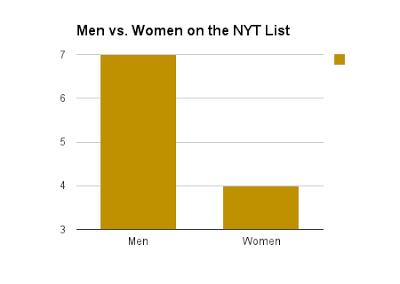
On average, there were 7 men on the list and 4 women. Again, these are the number of individuals, so authors who appeared more than once were only counted one time.
Let's look at this more granularly.
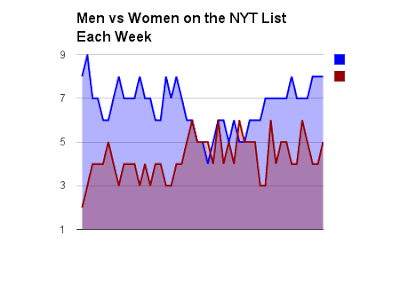
This is a week-by-week comparison of the number of men represented individually on the NYT List in blue against the number of women represented individually on the NYT list in red. Note that except for a few scant weeks in the middle of the chart -- that would be around May and June -- men appear more frequently on the list.
So how does the top ten fare when it comes to individual gender representation? If we remove the extended list, will women show up more frequently?
Not so much. In fact, the top ten list is even more disappointing to look at if you're looking for the proof of women dominating YA.
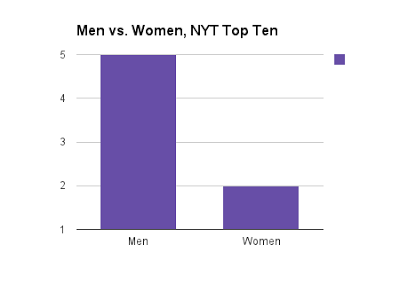
On average, men appeared 5 times on the top ten for YA, while women represented a scant 2. Again, these are the number of individuals, so authors who appeared more than once were only counted on time.
So more granularly:
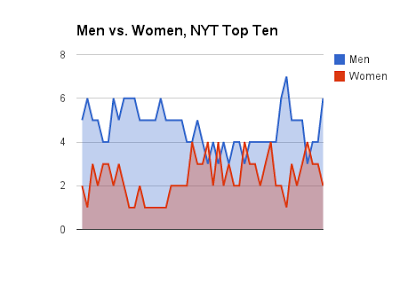 As should be absolutely clear, there has never been a time women have outnumbered men on the NYT List in the top ten. Never. There have been six weeks where there have been a grand total of four women in the top ten -- January 6, February 24, March 31, May 5, May 19, and June 9. For the weeks of May 5 and June 9, we had female coauthors on the top ten (each counted as an individual) and for the weeks of Mach 31 and June 9, Abbi Glines and Nicole Reed -- both "new adult" authors whose books were listed for readers 17 and older -- also occupied spots on the top ten.
As should be absolutely clear, there has never been a time women have outnumbered men on the NYT List in the top ten. Never. There have been six weeks where there have been a grand total of four women in the top ten -- January 6, February 24, March 31, May 5, May 19, and June 9. For the weeks of May 5 and June 9, we had female coauthors on the top ten (each counted as an individual) and for the weeks of Mach 31 and June 9, Abbi Glines and Nicole Reed -- both "new adult" authors whose books were listed for readers 17 and older -- also occupied spots on the top ten.
It gets more interesting if you look at how few spots individual women have had on the top ten list. There have been nine weeks when only one woman has had a spot on the top ten. That woman is, of course, Veronica Roth.
The fewest number of men to occupy space on the top ten list is 3, and that has only happened a grand total of five times.
Books and Gender Representation on the NYT YA Bestseller List
The charts above looked at the individuals represented on the lists. So despite an author having more than one book on the list, she or he only counted once.
In addition to looking at the unique frequencies of gender on the list, I decided to do a more thorough count of the books and their authors by gender to get a truer sense of how men and women occupied the list. This time, every book was looked at individually, rather than every author. Multiple books by the same author were counted each time in their respective author's gender column.
It got even less pretty for women who "dominate" YA.
First, looking at the books with the use of the extended list, here's what our averages are when it comes to spots that men have on the list and spots that women have on it:

On average, 9 of the books on the list are written by men and 6 are written by women.
Let's see what this looks like on a week-by-week basis, too.
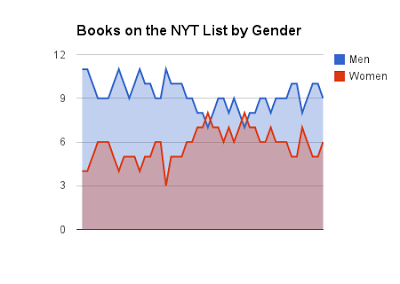
So about the fact that women dominate YA, take a hard look at this data.
Every single week -- except for two -- men have outnumbered women on the NYT List. Those were the weeks of March 31 and May 19, 2013. But before you get excited thinking that women had finally "taken over" in their representation on the list, I'll report to you that they didn't take over in numbers. Those weeks showed five individual women on the list, which is a number still smaller than the average number of men who appeared on a weekly basis. Women "dominated" as individuals none of the time.
Those five individual women on the list represented a grand total of 8 books on the 15-book extended list on those two weeks.
Eight books.
Five women.
Fifteen spots.
For two weeks out of forty-seven total.
Just sit with that for a few minutes.
There are, of course, some variables that made these two weeks of "lady domination" happen. For the week of March 31, we see the debut of Eleanor and Park, nearly a month after its release. But the sales for the book that week most certainly reflect the John Green review in The New York Times -- the review was published March 10, which is the week that the March 31 NYT List covers here. Without devaluing the book and its merits, it's fascinating to see that the book ended up on the List nearly a month after publishing but immediately following the glowing review it received in the same publication by a male who himself regularly occupies 3 or 4 spots on the list. It would be hard to argue that without the Green review that book would have landed on the list that week.
That week also includes Nicole Reed's "new adult" book (which I argue should not have been on this list at all because of its 17+ age recommendation and the fact it's self-published -- there is a whole other list for that). There were also two spots on the extended list held by Cassie Clare; the sales for this week were one week prior to the paperback release of Clockwork Prince, and I have some theories which I'll get to in a bit.
For the week of May 19, I note that Abbi Glines was on the list (who, again, I argue should not have been since her book was for a 17+ audience). There are also dual appearances by Kiera Cass, Marie Lu, Veronica Roth, and an appearance by Sarah Dessen for What Happened to Goodbye.
Because I looked at the data of individuals limited to the top ten list, I decided to do the same thing with the books. So the following charts look at gender representation in the top ten by books. Same deal: multiple books by the same author were gender coded multiple times.
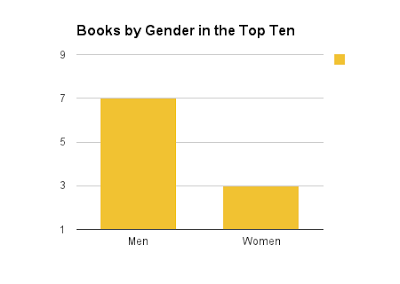 On average, there were 7 books written by men in the top ten of the NYT List and 3 by women.
On average, there were 7 books written by men in the top ten of the NYT List and 3 by women.
More granularly, so you can see what it looks like on a week-by-week basis:
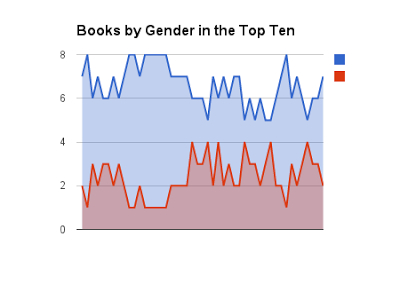 Books written by women have never once -- never once -- had at least half of the spaces on the top ten list. They've had a few weeks occupying four spaces but never have they had five books in the top ten slots in the 47 weeks that the YA List has existed.
Books written by women have never once -- never once -- had at least half of the spaces on the top ten list. They've had a few weeks occupying four spaces but never have they had five books in the top ten slots in the 47 weeks that the YA List has existed.
A couple of other factoids to include at this juncture: there have only been five weeks where a woman held the number one spot on the New York Times List for YA. Five. They were held by Veronica Roth (for four weeks -- three of which were in mid-July, on the 14th, 21st and 28th, which would reflect a bump in sales immediately following the release of the first stills of the movie and the fourth week, September 15, likely reflects sales following the release of the film's trailer) and Kiera Cass for The Elite, which stayed for one week only. Cass's novel debuted at #1 on the May 12 list, which reflects the sales for the week her book was available for purchase.
Again, in 47 weeks, there have only been two women to see the top spot. They only held it for a combined five weeks.
Average Length of Stay on the NYT List
This data is much trickier, it's limited to the top ten list, and it doesn't really say anything. But I wanted to look at it for comparison with the next data set after this one.
Because the list is only 47 weeks long, we only have 47 weeks to compare average length of stay against. And it moves backwards, of course: so the books which were on the list during week one had an average stay of one week. Those which were on the list during week 23 which had been there since week 1 now averaged 23 weeks. And so on.
I wanted to look at gender against the average stay of books on the list. But it wasn't really too telling of anything. Part of that is because the top ten list had a higher number of male authors on the list, though only a handful were around the entire 47 weeks (many jumped from the top ten list to the extended list then back again). And really, comparing 8 books by men's average stay on the list against 2 books by Veronica Roth which have been on the list the entire time didn't show a whole lot.
But it will tell us something soon.
For men, the average length of stay on the NYT YA List was 18 weeks.
For women, it was 17 weeks.
Keep those numbers in your head in conjunction with everything above.
Trends Within the NYT YA List
Tomorrow's post will look at some more data, including data from the first NYT List that will publish after Veronica Roth's series is off the YA list and onto the series list. It'll also look at publishers represented on the list and other interesting variables. But before ending this post, I thought it would be worth talking a little bit about some of the interesting trends I noticed.
I noted above more than once that lists reflect the sales two weeks prior to their publication date. That's something to keep in mind when you notice things like drastic e-book sales for certain titles or authors. Because the YA list does reflect e-book sales, I have been curious to know what impact that makes on who is on the list and who is getting those books on the list.
Ever notice huge slashes in e-book prices? I haven't kept track of them this year, and can't make any certain connections, but it seems to me there's something to be said about the appearance of some books on the list which might reflect those drastic cost reductions. Publishers can set the price of a Kindle or Nook Book at $1.99, drum up huge sales, get the book on the list, and then it's a bestseller. Doing that prior to a paperback release or a release of the next book within a series would help that title appear on the list. A lot of times those books appear for that week and then they fall off again when the price returns to something higher.
It is not price that gets books on the list; it's the number of sales.
Keep that in the back of your mind when the list for November 20 comes out, as last week a number of well-known YA names had their e-book prices dropped to $1.99 or even $1.40. I wouldn't be surprised to see Rainbow Rowell appear on the list twice, for example, since both of her books were dropped to a mere $1.40 for Kindle. I'd even not be surprised to see one or both of them in the top ten lists (I should note here that on the first post-Veronica Roth list, which I'll talk about tomorrow, Eleanor and Park is on the extended).
Many books will appear for a week or two on the list -- usually on the list reflecting the sales of the week their new book published -- and then they will slide off. This happens in more drastic numbers for female authors than male authors, which seems like it's reflected in the data above. And when you look at the titles that do this, it's hard not to think about why that might be. Is there a reason Kiera Cass's The Elite debuted at #1, lasted a second week at #6, moved to the extended, and then disappeared? It seems to me perhaps this sort of quick on and off reflects the true audience purchasing the book, and the true audience for this one? Teenagers. They get very excited about the release of the next book in a series, buy it during release week or immediately after, and then the sales fall off for any number of reasons. Books that are perennially on the NYT List definitely reflect teen sales, too, but I suspect part of why they maintain their positions is continued purchasing and recommendation from adult readers as "good YA." Even if it's only 55% of adults purchasing YA (which has been spun to sound like it's adults being huge purchasers of YA books when it's only slightly more than half of purchases are made by adults), it's likely that those adults recommended books to other adults are doing what adults who recommend books tend to do: repeat and recommend the books they read from the bestsellers list because that bestsellers list suggests a "good book." A bestseller is a bestseller for a reason, as the logic goes.
They're safe.
Books written by women are much more likely to see one week or two weeks on the list and then fall off than those by men. It's depressing to think about what that might say about the value of women in YA fiction, the reflection of their work as having significant merit, and so on and so forth. But one thing is for certain: the assertion that "women dominate" is completely false, at least when it comes to Bestsellerdom.
Men do.






 Related StoriesThe In-Between by Barbara StewartAudiobook Review: The Waking Dark by Robin WassermanAustin Reads
Related StoriesThe In-Between by Barbara StewartAudiobook Review: The Waking Dark by Robin WassermanAustin Reads
How often do we hear that YA is full of women? That this is a land where there aren't boys or men? That readers and writers are girls and the implications of what that might mean?
I've been thinking about this a lot lately. And I decided it was time to finally sit down and look at one of the most well-known and highly-revered tools that the book world looks to when it comes to status and acclaim: The New York Times Bestsellers List.
Before diving into the data and making some connections among the things I saw, I thought I'd break down the NYT list a little bit. You may or may not remember that last December, the Times decided they were going to change up how they handled their Children's lists. It used to be that all Children's books were on one list, thereby having 10 spots for books published among all categories for children. The change that was made ended up splitting middle grade and YA from the general Children's list, giving them their own lists. This offered more spots for books within those categories, and with the extension of the list, there are 15 books labeled "Bestsellers" each week.
In addition to those lists, there are series lists. When (theoretically) there are three books published within a given series of books, the books within that series are tied together and placed on the series list, rather than offered individual spots within the overall list.
The NYT list tracks sales within a given week and highest sales correlate to placement on the list. For YA (and MG), e-book sales are included in the totals, whereas children's sales are not. Keep this in mind with the data below because I think that those e-sales play a role in what emerges. Sales numbers are reported from big retailers, online and off, and rather than rehash all of the details of how it works out, it's worth reading the Wikipedia article to know what does and doesn't count, as well as the controversies surrounding the counting -- there are enough citations here to fill you with all kinds of glee, don't worry.
I've focused all of my number-crunching on only the YA list. There is nothing in here about the MG list and nothing in here about the series list, except where I've chosen to make it a relevant point. There is a big one, too. In total, I looked at 47 bestseller lists from the NYT, which is everything from the beginning of their separate list through the week of 11/5/13.
What you should know if you don't already is that the lists are printed two weeks in advance of the sales. In other words, the list for November 5 covers the sales for the week of October 13 through 20. Knowing this will contextualize much of what you see later on in the data, as books which are published on a certain date that would no doubt make the NYT List don't do so immediately -- there is a two-week lag in the reporting.
The reason that I pulled November 5 as my final counting date for the data is simple: the list for November 12 is one that changes the game, as it's the week when sales for Veronica Roth's Allegiant come through, and thus it's the week when the two spots she's held on the list for YA are opened up. Her series, now three books, leaps over to the series list instead. More on that in a bit.
Other notes I made in my data collecting I should share: when there were author teams, each of the authors counted. So when Maureen Johnson and Cassie Clare's book made the NYT list, each of them were tallied for women. The single exception to this came through a personal judgment call you may or may not agree with, but which changes the data and results very little. That exception came for books written by James Patterson and a co-author. I chose not to count the co-author because, as anyone who works with readers will tell you, it's Patterson who is the author. Readers do not ask for the Maxine Paetro book. They ask for the newest Patterson. Without his name leading the book, there is little doubt in my mind that that book would not make the list. I did also make an exception for the Gabrielle Douglas book, which is authored by her but was written "with" someone else. I did not count the person it was written "with," since "with" indicates something different than "by."
As in the past on data posts, there is a LOT to sift through here. I like numbers and correlations among them. I like to take guesses and talk about what I'm seeing and what I think it means. I invite you to do the same thing. As should be noted, I've rounded all of my numbers to the nearest whole to make the data easier to read.
You can see my raw data, with some miscellaneous notes-to-self, here.
Individual Gender Representation on the NYT YA List
The first thing I wanted to know was how well men and women were represented on the lists. I've always suspected that men outnumbered women on the list, and when I've made that claim before, I've been told that's not true.
But actually, it's startlingly true.
Starting on the very basic level, I counted up the number of different men and the number of different women who occupied a space within the NYT YA List. Because I wanted to cast the widest net possible from the beginning, I looked at not just the top ten list, but the extended list of 15.

On average, there were 7 men on the list and 4 women. Again, these are the number of individuals, so authors who appeared more than once were only counted one time.
Let's look at this more granularly.

This is a week-by-week comparison of the number of men represented individually on the NYT List in blue against the number of women represented individually on the NYT list in red. Note that except for a few scant weeks in the middle of the chart -- that would be around May and June -- men appear more frequently on the list.
So how does the top ten fare when it comes to individual gender representation? If we remove the extended list, will women show up more frequently?
Not so much. In fact, the top ten list is even more disappointing to look at if you're looking for the proof of women dominating YA.

On average, men appeared 5 times on the top ten for YA, while women represented a scant 2. Again, these are the number of individuals, so authors who appeared more than once were only counted on time.
So more granularly:
 As should be absolutely clear, there has never been a time women have outnumbered men on the NYT List in the top ten. Never. There have been six weeks where there have been a grand total of four women in the top ten -- January 6, February 24, March 31, May 5, May 19, and June 9. For the weeks of May 5 and June 9, we had female coauthors on the top ten (each counted as an individual) and for the weeks of Mach 31 and June 9, Abbi Glines and Nicole Reed -- both "new adult" authors whose books were listed for readers 17 and older -- also occupied spots on the top ten.
As should be absolutely clear, there has never been a time women have outnumbered men on the NYT List in the top ten. Never. There have been six weeks where there have been a grand total of four women in the top ten -- January 6, February 24, March 31, May 5, May 19, and June 9. For the weeks of May 5 and June 9, we had female coauthors on the top ten (each counted as an individual) and for the weeks of Mach 31 and June 9, Abbi Glines and Nicole Reed -- both "new adult" authors whose books were listed for readers 17 and older -- also occupied spots on the top ten. It gets more interesting if you look at how few spots individual women have had on the top ten list. There have been nine weeks when only one woman has had a spot on the top ten. That woman is, of course, Veronica Roth.
The fewest number of men to occupy space on the top ten list is 3, and that has only happened a grand total of five times.
Books and Gender Representation on the NYT YA Bestseller List
The charts above looked at the individuals represented on the lists. So despite an author having more than one book on the list, she or he only counted once.
In addition to looking at the unique frequencies of gender on the list, I decided to do a more thorough count of the books and their authors by gender to get a truer sense of how men and women occupied the list. This time, every book was looked at individually, rather than every author. Multiple books by the same author were counted each time in their respective author's gender column.
It got even less pretty for women who "dominate" YA.
First, looking at the books with the use of the extended list, here's what our averages are when it comes to spots that men have on the list and spots that women have on it:

On average, 9 of the books on the list are written by men and 6 are written by women.
Let's see what this looks like on a week-by-week basis, too.

So about the fact that women dominate YA, take a hard look at this data.
Every single week -- except for two -- men have outnumbered women on the NYT List. Those were the weeks of March 31 and May 19, 2013. But before you get excited thinking that women had finally "taken over" in their representation on the list, I'll report to you that they didn't take over in numbers. Those weeks showed five individual women on the list, which is a number still smaller than the average number of men who appeared on a weekly basis. Women "dominated" as individuals none of the time.
Those five individual women on the list represented a grand total of 8 books on the 15-book extended list on those two weeks.
Eight books.
Five women.
Fifteen spots.
For two weeks out of forty-seven total.
Just sit with that for a few minutes.
There are, of course, some variables that made these two weeks of "lady domination" happen. For the week of March 31, we see the debut of Eleanor and Park, nearly a month after its release. But the sales for the book that week most certainly reflect the John Green review in The New York Times -- the review was published March 10, which is the week that the March 31 NYT List covers here. Without devaluing the book and its merits, it's fascinating to see that the book ended up on the List nearly a month after publishing but immediately following the glowing review it received in the same publication by a male who himself regularly occupies 3 or 4 spots on the list. It would be hard to argue that without the Green review that book would have landed on the list that week.
That week also includes Nicole Reed's "new adult" book (which I argue should not have been on this list at all because of its 17+ age recommendation and the fact it's self-published -- there is a whole other list for that). There were also two spots on the extended list held by Cassie Clare; the sales for this week were one week prior to the paperback release of Clockwork Prince, and I have some theories which I'll get to in a bit.
For the week of May 19, I note that Abbi Glines was on the list (who, again, I argue should not have been since her book was for a 17+ audience). There are also dual appearances by Kiera Cass, Marie Lu, Veronica Roth, and an appearance by Sarah Dessen for What Happened to Goodbye.
Because I looked at the data of individuals limited to the top ten list, I decided to do the same thing with the books. So the following charts look at gender representation in the top ten by books. Same deal: multiple books by the same author were gender coded multiple times.
 On average, there were 7 books written by men in the top ten of the NYT List and 3 by women.
On average, there were 7 books written by men in the top ten of the NYT List and 3 by women.More granularly, so you can see what it looks like on a week-by-week basis:
 Books written by women have never once -- never once -- had at least half of the spaces on the top ten list. They've had a few weeks occupying four spaces but never have they had five books in the top ten slots in the 47 weeks that the YA List has existed.
Books written by women have never once -- never once -- had at least half of the spaces on the top ten list. They've had a few weeks occupying four spaces but never have they had five books in the top ten slots in the 47 weeks that the YA List has existed.A couple of other factoids to include at this juncture: there have only been five weeks where a woman held the number one spot on the New York Times List for YA. Five. They were held by Veronica Roth (for four weeks -- three of which were in mid-July, on the 14th, 21st and 28th, which would reflect a bump in sales immediately following the release of the first stills of the movie and the fourth week, September 15, likely reflects sales following the release of the film's trailer) and Kiera Cass for The Elite, which stayed for one week only. Cass's novel debuted at #1 on the May 12 list, which reflects the sales for the week her book was available for purchase.
Again, in 47 weeks, there have only been two women to see the top spot. They only held it for a combined five weeks.
Average Length of Stay on the NYT List
This data is much trickier, it's limited to the top ten list, and it doesn't really say anything. But I wanted to look at it for comparison with the next data set after this one.
Because the list is only 47 weeks long, we only have 47 weeks to compare average length of stay against. And it moves backwards, of course: so the books which were on the list during week one had an average stay of one week. Those which were on the list during week 23 which had been there since week 1 now averaged 23 weeks. And so on.
I wanted to look at gender against the average stay of books on the list. But it wasn't really too telling of anything. Part of that is because the top ten list had a higher number of male authors on the list, though only a handful were around the entire 47 weeks (many jumped from the top ten list to the extended list then back again). And really, comparing 8 books by men's average stay on the list against 2 books by Veronica Roth which have been on the list the entire time didn't show a whole lot.
But it will tell us something soon.
For men, the average length of stay on the NYT YA List was 18 weeks.
For women, it was 17 weeks.
Keep those numbers in your head in conjunction with everything above.
Trends Within the NYT YA List
Tomorrow's post will look at some more data, including data from the first NYT List that will publish after Veronica Roth's series is off the YA list and onto the series list. It'll also look at publishers represented on the list and other interesting variables. But before ending this post, I thought it would be worth talking a little bit about some of the interesting trends I noticed.
I noted above more than once that lists reflect the sales two weeks prior to their publication date. That's something to keep in mind when you notice things like drastic e-book sales for certain titles or authors. Because the YA list does reflect e-book sales, I have been curious to know what impact that makes on who is on the list and who is getting those books on the list.
Ever notice huge slashes in e-book prices? I haven't kept track of them this year, and can't make any certain connections, but it seems to me there's something to be said about the appearance of some books on the list which might reflect those drastic cost reductions. Publishers can set the price of a Kindle or Nook Book at $1.99, drum up huge sales, get the book on the list, and then it's a bestseller. Doing that prior to a paperback release or a release of the next book within a series would help that title appear on the list. A lot of times those books appear for that week and then they fall off again when the price returns to something higher.
It is not price that gets books on the list; it's the number of sales.
Keep that in the back of your mind when the list for November 20 comes out, as last week a number of well-known YA names had their e-book prices dropped to $1.99 or even $1.40. I wouldn't be surprised to see Rainbow Rowell appear on the list twice, for example, since both of her books were dropped to a mere $1.40 for Kindle. I'd even not be surprised to see one or both of them in the top ten lists (I should note here that on the first post-Veronica Roth list, which I'll talk about tomorrow, Eleanor and Park is on the extended).
Many books will appear for a week or two on the list -- usually on the list reflecting the sales of the week their new book published -- and then they will slide off. This happens in more drastic numbers for female authors than male authors, which seems like it's reflected in the data above. And when you look at the titles that do this, it's hard not to think about why that might be. Is there a reason Kiera Cass's The Elite debuted at #1, lasted a second week at #6, moved to the extended, and then disappeared? It seems to me perhaps this sort of quick on and off reflects the true audience purchasing the book, and the true audience for this one? Teenagers. They get very excited about the release of the next book in a series, buy it during release week or immediately after, and then the sales fall off for any number of reasons. Books that are perennially on the NYT List definitely reflect teen sales, too, but I suspect part of why they maintain their positions is continued purchasing and recommendation from adult readers as "good YA." Even if it's only 55% of adults purchasing YA (which has been spun to sound like it's adults being huge purchasers of YA books when it's only slightly more than half of purchases are made by adults), it's likely that those adults recommended books to other adults are doing what adults who recommend books tend to do: repeat and recommend the books they read from the bestsellers list because that bestsellers list suggests a "good book." A bestseller is a bestseller for a reason, as the logic goes.
They're safe.
Books written by women are much more likely to see one week or two weeks on the list and then fall off than those by men. It's depressing to think about what that might say about the value of women in YA fiction, the reflection of their work as having significant merit, and so on and so forth. But one thing is for certain: the assertion that "women dominate" is completely false, at least when it comes to Bestsellerdom.
Men do.







 Related StoriesThe In-Between by Barbara StewartAudiobook Review: The Waking Dark by Robin WassermanAustin Reads
Related StoriesThe In-Between by Barbara StewartAudiobook Review: The Waking Dark by Robin WassermanAustin Reads
Published on November 03, 2013 22:00
November 1, 2013
Links of Note: November 2, 2013
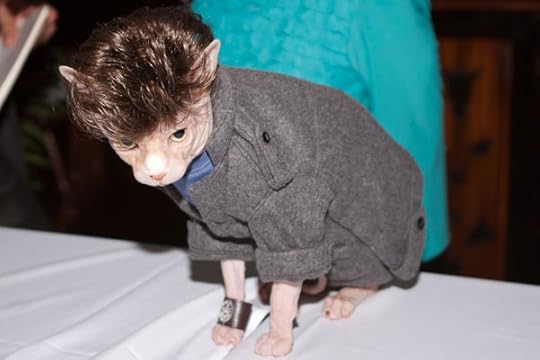
This is a cat dressed like Edward Cullen. These pets in literary-inspired costumes are ridiculously amusing.
Ready for a roundup of all things book, literary, reading, and otherwise worth clicking? I've got a mix of all kinds of stuff to share.
Remember a few weeks ago that survey about book blogging? The results from that survey are in, and it's interesting to see how long people have been blogging and what's made their blogging change. Anyone who blogs goes through times of feast and times of famine, and it's comforting to look at these results and feel like you're not alone in those experiences.
We don't cover middle grade much here, but I do like to keep tabs on it. Angie Manfredi has a really nice reader's guide for those who are looking for the next books to read or give to readers who love the Percy Jackson series. And if you haven't been following Sarah Thompson's excellent "So you want to read middle grade?" series, you should.
If you haven't read Eliot Schrefer's New York Times piece about the value of YA books, it's a good one. No confessional or persuasion here. Just reason.
"It's amazing how many different ways you will hear this kind of sentiment leaving the mouths of a disappointing amount of people. Another book about a girl falling in love. Another book about a girl with trauma. Another book about mean girls. Oh no not another book about a girl that is breathing and alive and on and on and on. Why write them? When is enough enough with these girl stories? I think I was ready for just about anything in terms of push-back relating to the questions I hoped my work was asking about gender expectations and stereotypes relating to girls, but I was not prepared to hear those questions weren't worth asking in the first place." Courtney Summers's excellent post about writing for girls has got me thinking about how we as readers interpret, react to, and invest in stories about girls. There's a LOT to dig out here.
Follow up reading that post with this one by A. M. Jenkins who talks about writing girls and writing boys in YA fiction and the different reactions and responses to them.
Malinda Lo looks at a decade of slow but steady change when it comes to LGBTQ books and mainstream publishing. Charts, graphs, and data that is more than worthwhile to think about.
A look at what it's like to be the ghostwriter for V. C. Andrews. This is a neat little piece, and I especially find it interesting the bit about needing to take so many copious notes since fans notice little things, like the change in eye color of a minor character.
Elizabeth Wein looks closely at who is buying YA books -- is it really as many adults as we've made it out to be?
So is it a microtrend (or a full-blown trend?) that YA horror series that used to be popular are being rebooted? I blogged about it earlier this month, and that was before news of R. L. Stine would be reviving his "Fear Street" series.
Here are 6 fun and interesting charts and info graphics about YA fiction. While I am on the topic of visual information presentation, allow me to point you in the direction of two awesome infographics about YA lit from Molly Wetta: Choose your own YA Apocalypse and What would Katniss read?
What must it be like to be a male cover model on a YA book? There's an interview for that.
I read three great posts this month about the notion of impostor syndrome and what it feels like to never feel like you're enough (or that you're faking it all). Cory kicks it off, followed by this post by Abby, and it wraps up with a post by Char Booth.
Design*Sponge is one of the blogs I regularly read that has absolutely nothing to do with books (and I LOVE it so much). But recently, they had a really fascinating piece about book covers and what they do or don't do in today's world. It's interesting to read about this from outside the book world. This is nice long-form journalism.
I've had a number of posts over at Book Riot these last couple of weeks, too. I've talked about what happens when fans are disappointed by the finale in a book series (without spoilers), I created a downloadable crossword puzzle and reading list to YA zombie lit, the differences between criticism and censorship, and I made a booklist of YA stories set in 24 hours or fewer.
Have you read anything great in the last couple of weeks I should know about? I'd love to know in the comments!







 Related StoriesLinks of Note: October 5, 2013Links of Note: 9/21/13Links of Note: 9/7/13
Related StoriesLinks of Note: October 5, 2013Links of Note: 9/21/13Links of Note: 9/7/13
Published on November 01, 2013 22:00
October 31, 2013
The In-Between by Barbara Stewart
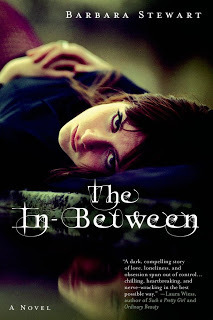 Barbara Stewart's The In-Between begins when Ellie, along with her mom, dad, and her cat, are in a car accident in the Poconos. They were moving from a small town in Pennsylvania to a smaller town in New York, where dad was taking a new job, mom was studying for her real estate license, and where Ellie could get a fresh start. Fourteen-year-old Ellie was -- and is -- troubled. Best friend Priscilla wasn't the friend she thought she was, and she went through her life in a state of unease, disappointment, and ultimately, she attempted suicide as a means out. But the car accident puts everything into a different type of tail spin. Just as things felt like they could be a fresh start, they're not.
Barbara Stewart's The In-Between begins when Ellie, along with her mom, dad, and her cat, are in a car accident in the Poconos. They were moving from a small town in Pennsylvania to a smaller town in New York, where dad was taking a new job, mom was studying for her real estate license, and where Ellie could get a fresh start. Fourteen-year-old Ellie was -- and is -- troubled. Best friend Priscilla wasn't the friend she thought she was, and she went through her life in a state of unease, disappointment, and ultimately, she attempted suicide as a means out. But the car accident puts everything into a different type of tail spin. Just as things felt like they could be a fresh start, they're not.When Ellie awakes and finds herself in her new home, she's visited by the ghost of her deceased mother. The car accident had killed her and left just Ellie and her father to build a new life together. But Ellie sensed mom all around her; mom often pressed into her palm, reassuring her that even in the afterlife, her presence was still around.
So was the presence of Madeline.
Madeline was everything Ellie ever wanted to be. Stylish. Fun. A little bit wild and unashamed. This was not just who Ellie hoped to be in her new town, but Madeline was also the kind of person Ellie wanted to be friends with. They spent countless hours together, and it was Madeline who Ellie opened up to about everything: her broken friendships back in her old town, her depression, her suicide attempt, everything. Ellie and Madeline's relationship bordered on obsessive; Ellie couldn't stop thinking about her and desiring to be with her at all times. She even let Madeline tattoo her body with an "ME" over he heart -- "ME" standing, of course, for "Madeline" and "Ellie." Mostly.
But Ellie's father wasn't the one who survived the accident. He died. He never got to be at the new house. Ellie's mother was the one who lived. So when Ellie wakes up -- really wakes up -- from the accident, everything in the house feels familiar, but her father isn's there. Her mother is. And Madeline isn't really there either. Except her presence is. On top of the weird and unnerving deja vu, Ellie has to be nice to Autumn, a girl who lives near her, who her mother wants her to be friend, and who is too much like the people back in her old town that she didn't like. Fortunately, Ellie also meets Jess, a popular girl. But Jess won't befriend her, not really. And Autumn will get a very different impression of Ellie when Ellie admits to trying to kill herself, to the strange visions she's seen, and to Madeline.
It's a sonogram in a box of items that makes things snap into place for Ellie. First when she discovers it in her afterlife with her dad, and second, when she confronts her mother about it. But mom isn't forthcoming. Mom won't be forthcoming. Mom insists Ellie mind her own business, get herself together to be the New Ellie she's supposed to be in her new life, and spend more time with Autumn as a means to get there.
Ellie can't stop thinking about Madeline. Can't stop embodying her spirit. Can't stop embodying her.
The In-Between is wonderfully complex -- as a reader you're never sure what reality Ellie is taking you through. Is she mentally ill? Is this a side effect of the car accident, in that she's seeing and connecting with spirits that reside in her mind? Or is Ellie truly being visited by a ghost in this new place? There are many layers to this cake, and each one makes sense alone. Together, they blur the lines between reality and madness, between mental illness and the supernatural. I love books that do this, forcing the reader to consider the lines between what mental illness is and what the supernatural may be. In many ways, Stewart's novel is reminiscent of Nova Ren Suma's Imaginary Girls or 17 & Gone because of this.
There aren't answers here, either, so spending time trying to find an explanation isn't worthwhile. The story is about that unknowing, that line in between madness and sanity. Between the real world and the not-so-real world. Is there a distinction? Should there be one? Does it matter?
Of course, Ellie offers ideas, and the way the book is written, she is in many ways addressing a readership. This isn't a diary. But maybe it is a diary. It's never entirely clear whether Ellie is alive or dead. Whether Madeline is the one alive or dead. Plenty of the holes in the story could lead readers to believe either story or explanation. Ellie isn't entirely reliable, and we know this near-immediately. We first believe she's living with her father in the new house, then we're told shortly after that she's living with her mother. That her mother is pregnant with twins.
Twins.
Stewart weaves into the story an element about twins. The sonogram Ellie discovers shows that when she was in utero, she wasn't alone. She'd had a twin, but that twin had disappeared. There hadn't been a miscarriage; it was vanishing twin syndrome. Armed with that knowledge, as well as her own experiences with depression and suicide, Ellie tells herself that the reason for her life never being good was because she was a murderer event before she was born. That because of her, her twin sister Madeline never got the chance to live. That because of her, the good girl, the cool girl, the one who would have been popular and well-liked and a good daughter never got the chance to exist. Instead, she can only exist in the mind of Ellie and within the body of Ellie.
Ellie is just her carrier.
Mom being pregnant with twins post-accident, post-death of her father, is both the best thing and the worst thing Ellie can imagine. The best because her siblings will have one another. The worst because what does that leave Ellie? Ultimately, it is those twins -- and what happens to them -- that forces Ellie to confront Madeline head-on. And, ultimately, it's where the story leaves readers wondering what just happened, what will happen, and whether we've been taken on a wild ride with Ellie's mental illness.
Stewart's writing is crisp, tight, and completely believable. Many YA books featuring younger teen protagonists can miss the mark. Here, Ellie is 14. Though the book does tackle the creepy head on, and though Ellie does discuss her suicide attempt and does participate in an act of violence, the book is suitable for younger teen readers. The story is a trip, and because it's not one which has any solid resolution, it will frustrate those readers who seek answers. Fortunately, many readers who love darker stories, who love horror and the supernatural and ghosts, will be very satisfied with how many possibilities exist in this book. Because what is living? What is death? Can we exist in a world between the two of them and interact with both sides? Does mental illness hold the power to allow both sides in?
And perhaps "ME" means something greater than simply Madeline and Ellie.
Pass this off to readers who love Nova Ren Suma's Imaginary Girls or 17 & Gone. In many ways, this reminded me of Sarah McCarry's All Our Pretty Songs in terms of writing -- it's got a magical quality to it that doesn't override the story.
Review copy received via the publisher. The In-Between will be available November 5 from St. Martin's Press.







 Related StoriesAudiobook Review: The Waking Dark by Robin WassermanJuvie by Steve WatkinsAustin Reads
Related StoriesAudiobook Review: The Waking Dark by Robin WassermanJuvie by Steve WatkinsAustin Reads
Published on October 31, 2013 22:00



